Your kitchen deserves lighting that does more than just help you see what you're chopping. The right lighting transforms your space from purely functional to absolutely stunning—and trust me, it's easier than you think. Whether you're working with a tiny galley or a sprawling open concept, there are lighting tricks that'll make your kitchen feel bigger, brighter, and way more inviting. From sleek modern solutions to cozy traditional touches, I've rounded up 20 lighting ideas that'll completely change how your kitchen looks and feels. Ready to turn your kitchen into the heart of your home?
1. Kitchen Lighting Under Cabinet LED Strip Systems
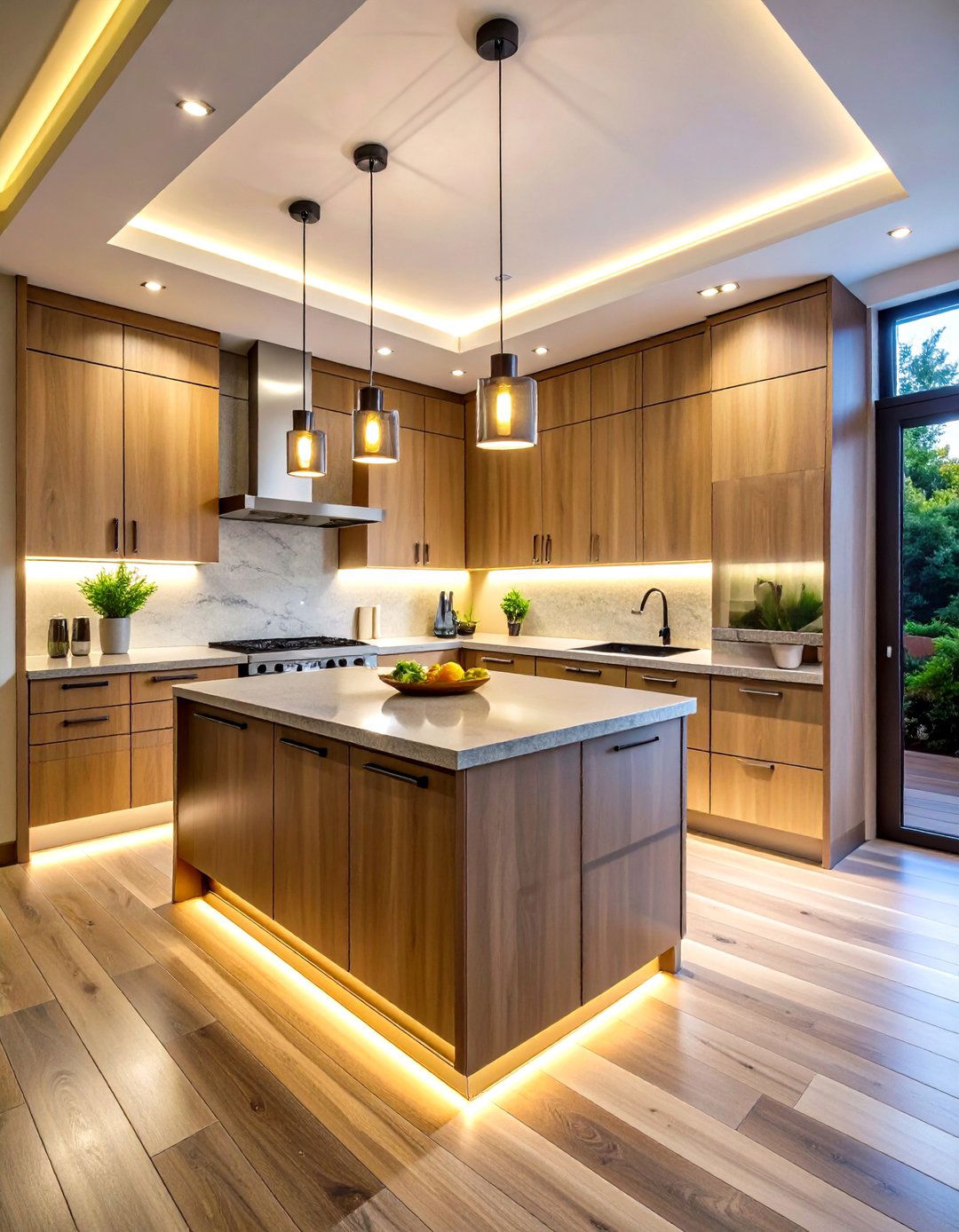
Under cabinet kitchen lighting creates seamless task illumination that eliminates shadows on countertops while adding contemporary appeal. LED strip lights installed beneath upper cabinets provide consistent, energy-efficient lighting for food preparation areas. These low-profile systems feature adjustable color temperatures from warm 2700K to cool 4000K, allowing customization for different times of day. Modern strip lights include dimming capabilities and can be hardwired or plug-in installations. The clean lines of aluminum channels with frosted diffusers create professional-grade lighting that transforms ordinary cabinets into illuminated design features, making your kitchen workspace both functional and visually striking.
2. Kitchen Lighting Pendant Island Statement Fixtures
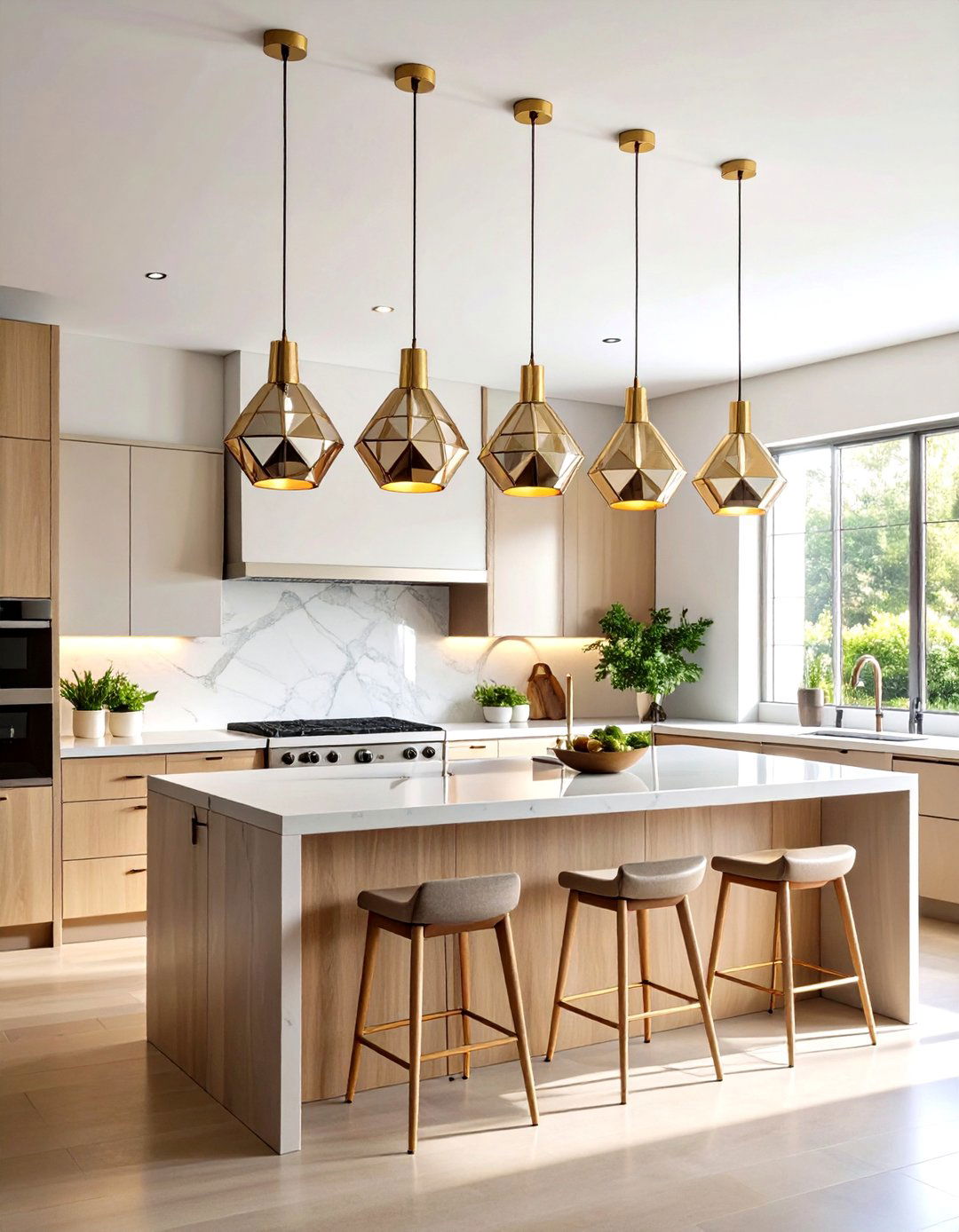
Kitchen lighting pendant fixtures above islands serve as both functional task lighting and dramatic design centerpieces. Current trends favor proportional sizing with multiple smaller pendants rather than oversized single fixtures, creating balanced illumination across large islands. Popular styles include clear glass globes, natural materials like rattan or wood, and sculptural metal designs with geometric shapes. Proper installation requires 30-36 inches of clearance above the countertop, with spacing adjusted for island length. These pendant lights provide focused illumination for food preparation while establishing the kitchen's aesthetic tone, offering endless customization through finishes, shapes, and grouping arrangements.
3. Kitchen Lighting Recessed Ceiling Comprehensive Coverage

Recessed kitchen lighting provides clean, unobtrusive general illumination that makes spaces feel larger and more open. Modern LED recessed lights offer superior energy efficiency and longevity compared to traditional options. Strategic placement includes perimeter spacing 18-24 inches from walls and 4-6 feet between fixtures for even coverage. Adjustable trim options allow directional lighting toward specific work areas. Dimming capabilities enable transitioning from bright task lighting during cooking to softer ambient lighting for dining. The minimal visual profile of recessed fixtures works with any design style while providing essential base lighting that other fixtures can layer upon.
4. Kitchen Lighting Track System Flexible Solutions
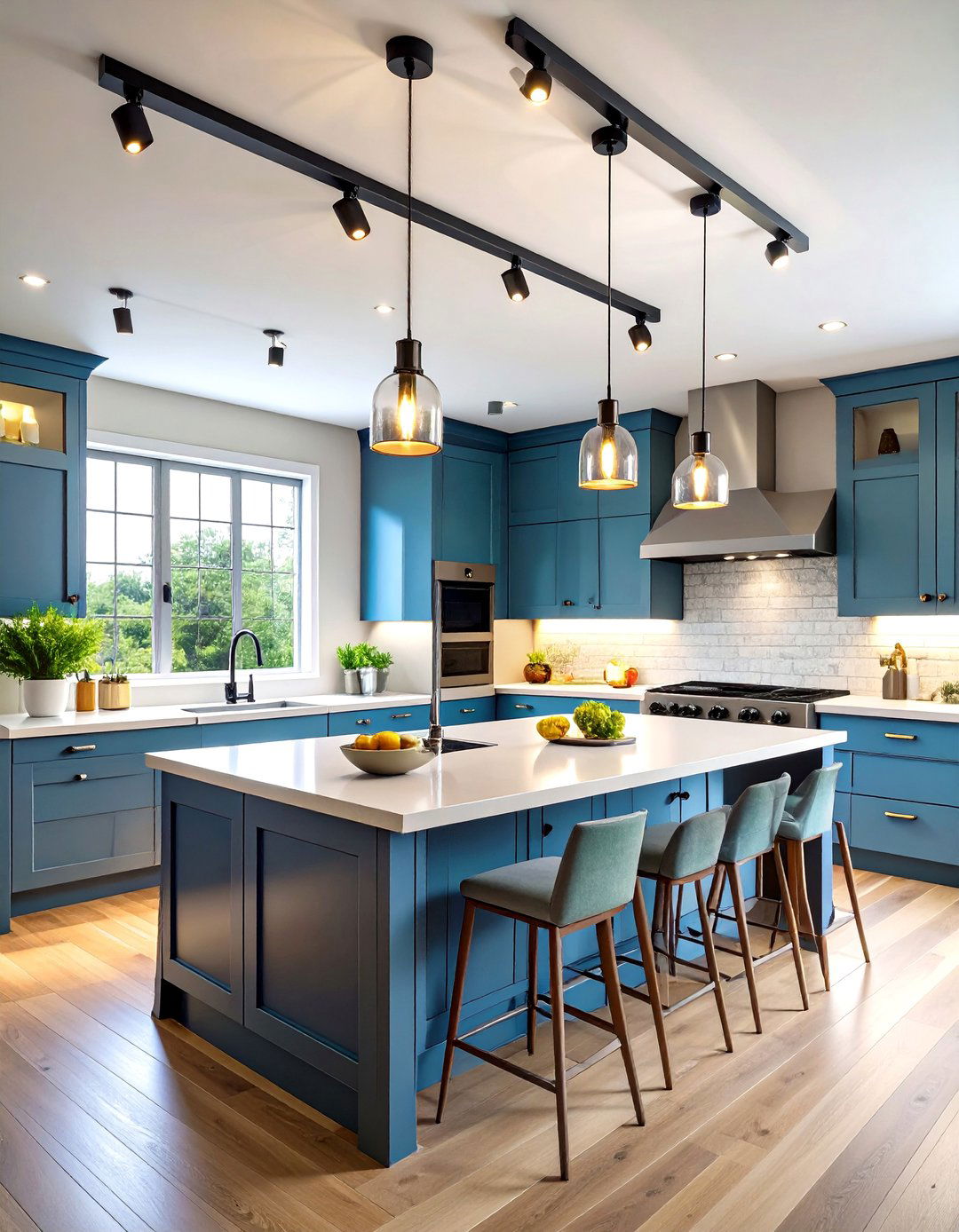
Track kitchen lighting systems offer unparalleled flexibility for directing light exactly where needed. Modern track systems include standard rigid rails, curved monorail options, and cable-suspended designs that create industrial aesthetics. Multiple adjustable heads along each track can spotlight different work zones, artwork, or architectural features. Current trends favor sleek black or brass finishes that complement contemporary kitchen hardware. Track lighting excels in galley kitchens or spaces with unique layouts where traditional fixtures might not provide adequate coverage. The ability to reposition lights as needs change makes track systems particularly valuable for evolving kitchen spaces.
5. Kitchen Lighting Chandelier Dining Area Elegance
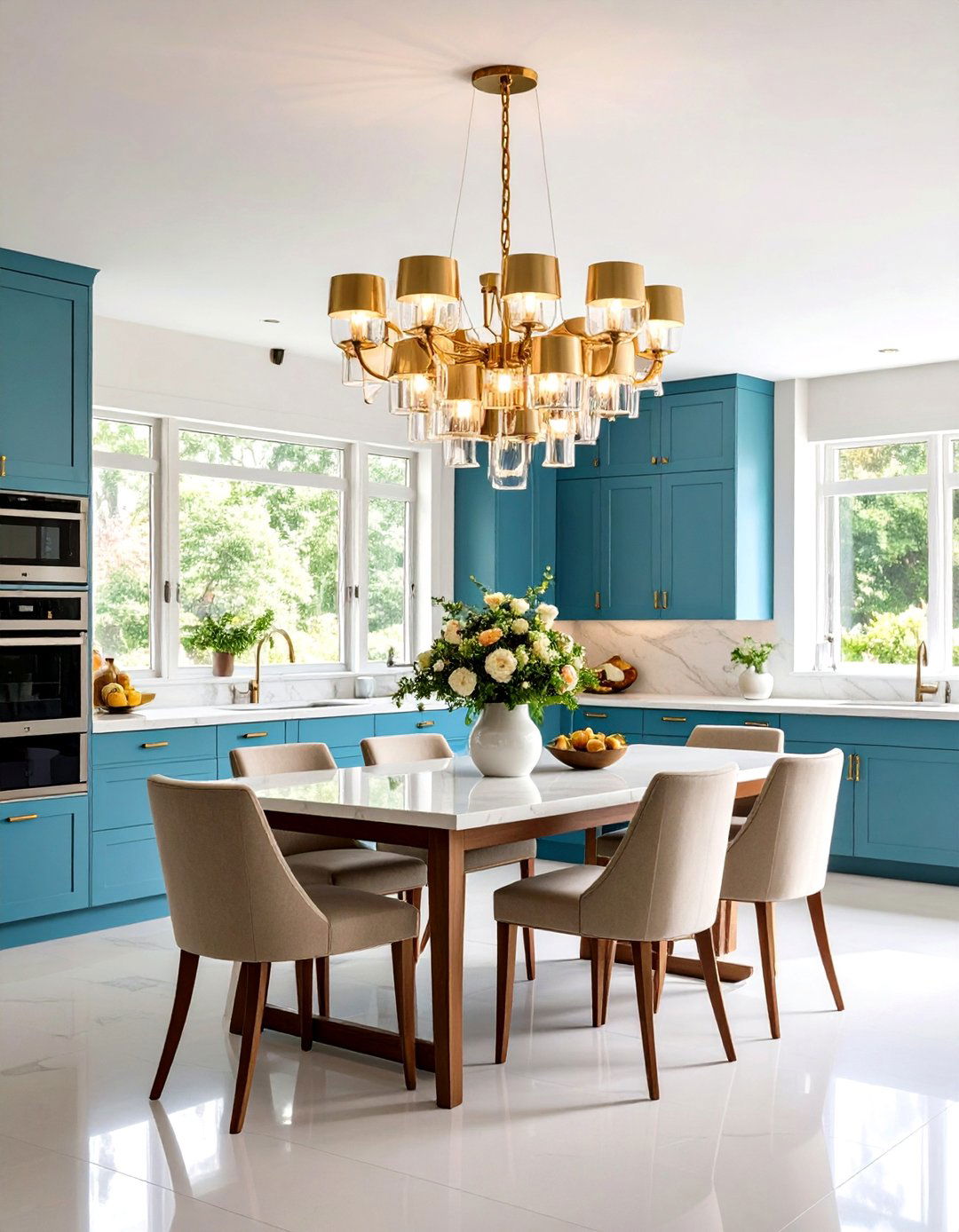
Kitchen lighting chandeliers in dining areas create sophisticated focal points that elevate meal experiences. Modern kitchen chandeliers move beyond traditional crystal designs toward sculptural pieces featuring mixed materials, geometric shapes, and artistic elements. Linear chandeliers work particularly well over rectangular dining tables, while round fixtures complement circular seating arrangements. Proper sizing requires fixtures to be 12 inches narrower than the table width, hung 30-35 inches above the surface. Contemporary options include brass accents, black metal frameworks, and organic shapes that bridge the gap between formal and casual dining while providing beautiful ambient lighting.
6. Kitchen Lighting Toe-Kick Base Cabinet Accent
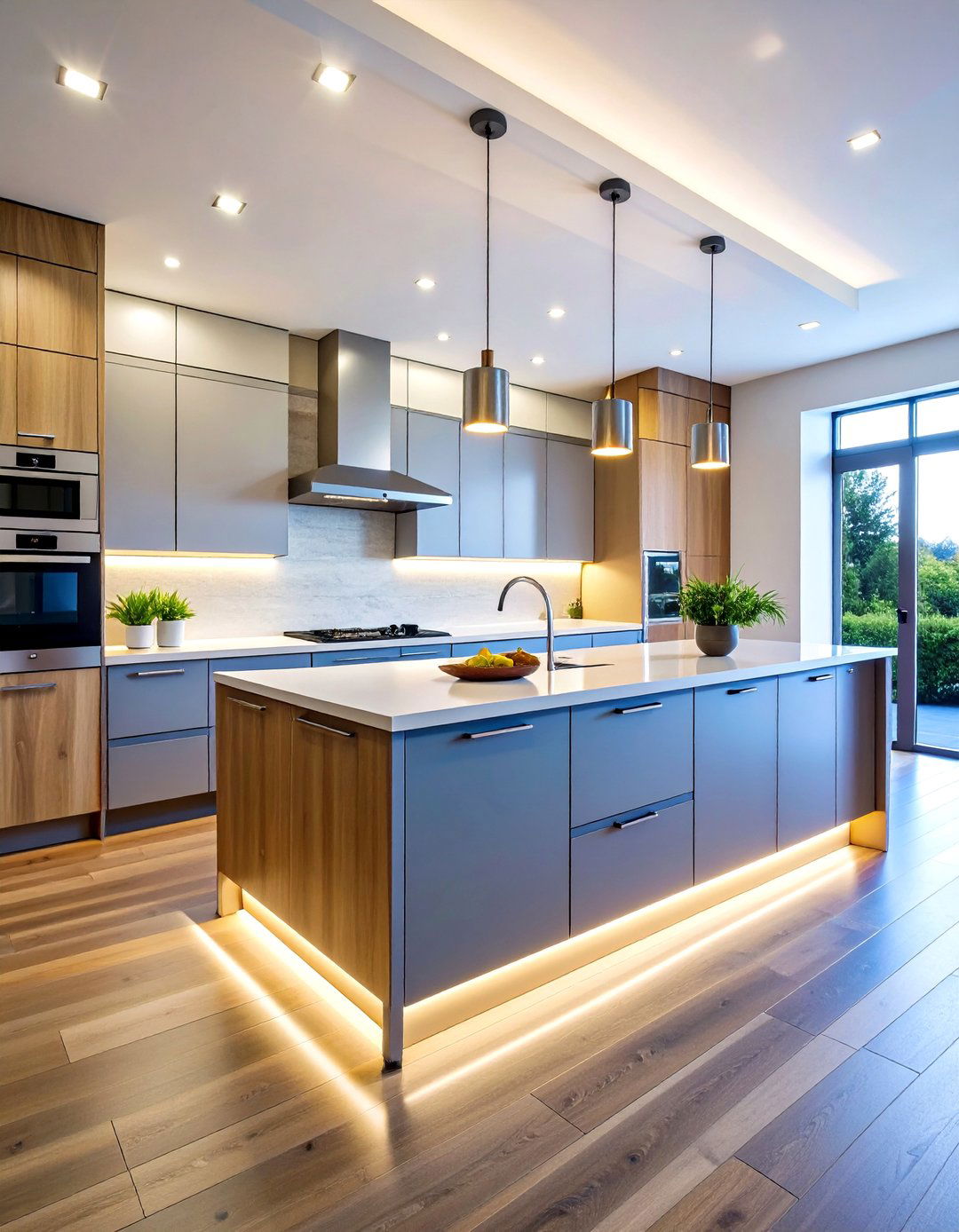
Toe-kick kitchen lighting creates stunning accent illumination that appears to float cabinetry above the floor. LED strips installed beneath base cabinets provide subtle pathway lighting for nighttime navigation while adding sophisticated ambiance. This lighting technique works particularly well in modern and contemporary kitchens where clean lines are emphasized. Warm white LEDs (2700K-3000K) create inviting atmosphere without harsh glare. Installation involves running low-voltage wiring through cabinet bases, making professional installation recommended. Toe-kick lighting can be controlled separately from main kitchen lighting, offering gentle illumination for early morning or late evening activities without disturbing others.
7. Kitchen Lighting Wall Sconce Task and Accent
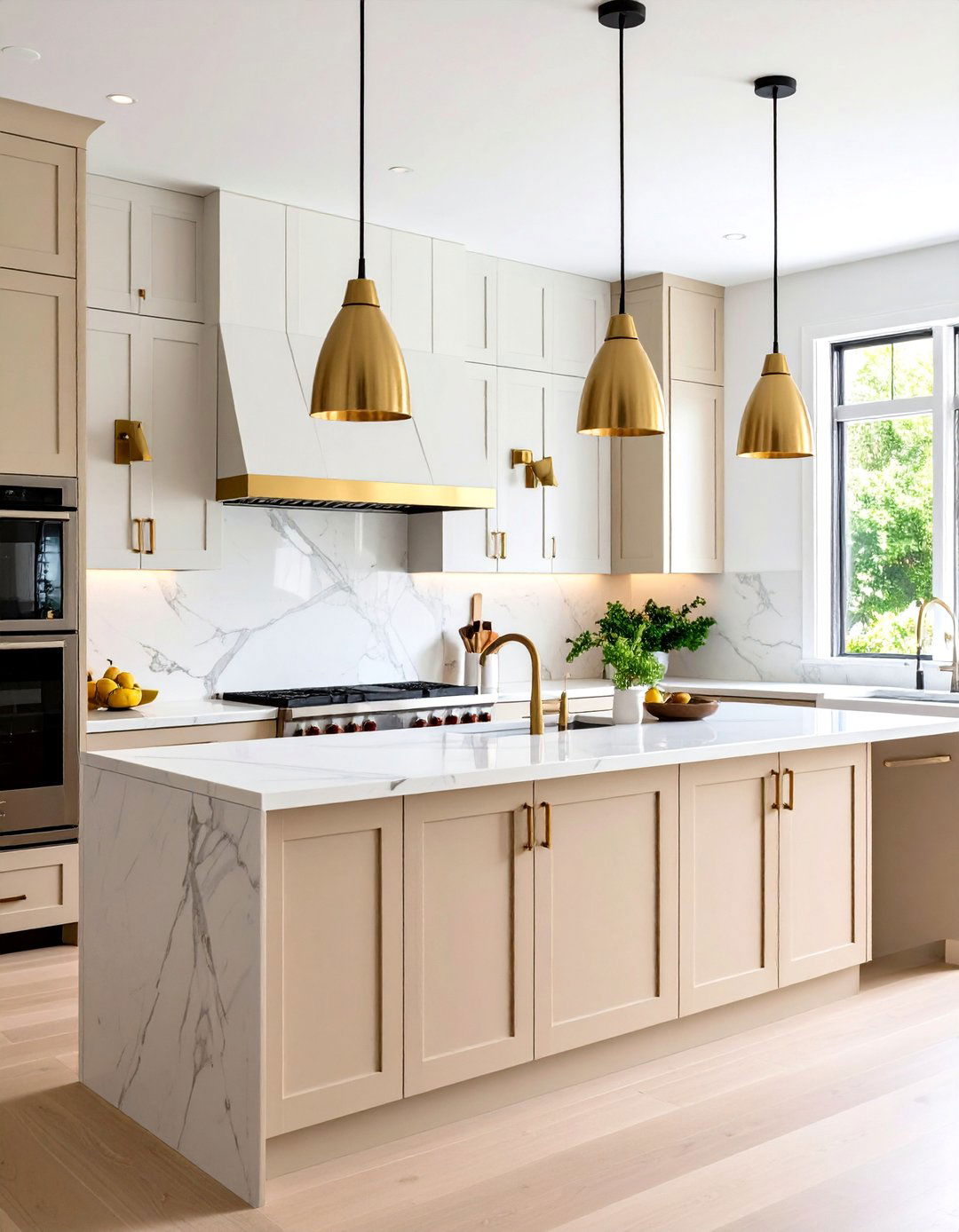
Wall sconce kitchen lighting provides targeted task illumination while adding decorative elements to vertical surfaces. Sconces flanking ranges, sinks, or preparation areas offer focused lighting that supplements overhead fixtures. Current trends include brass and black finishes, geometric shapes, and fixtures with both up and down light distribution. Picture lights mounted above open shelving highlight dishware and decorative items. Swing-arm sconces near seating areas provide adjustable reading light. These fixtures add layers to kitchen lighting schemes while contributing to the overall design aesthetic through their architectural presence and material choices.
8. Kitchen Lighting Smart Technology Integration
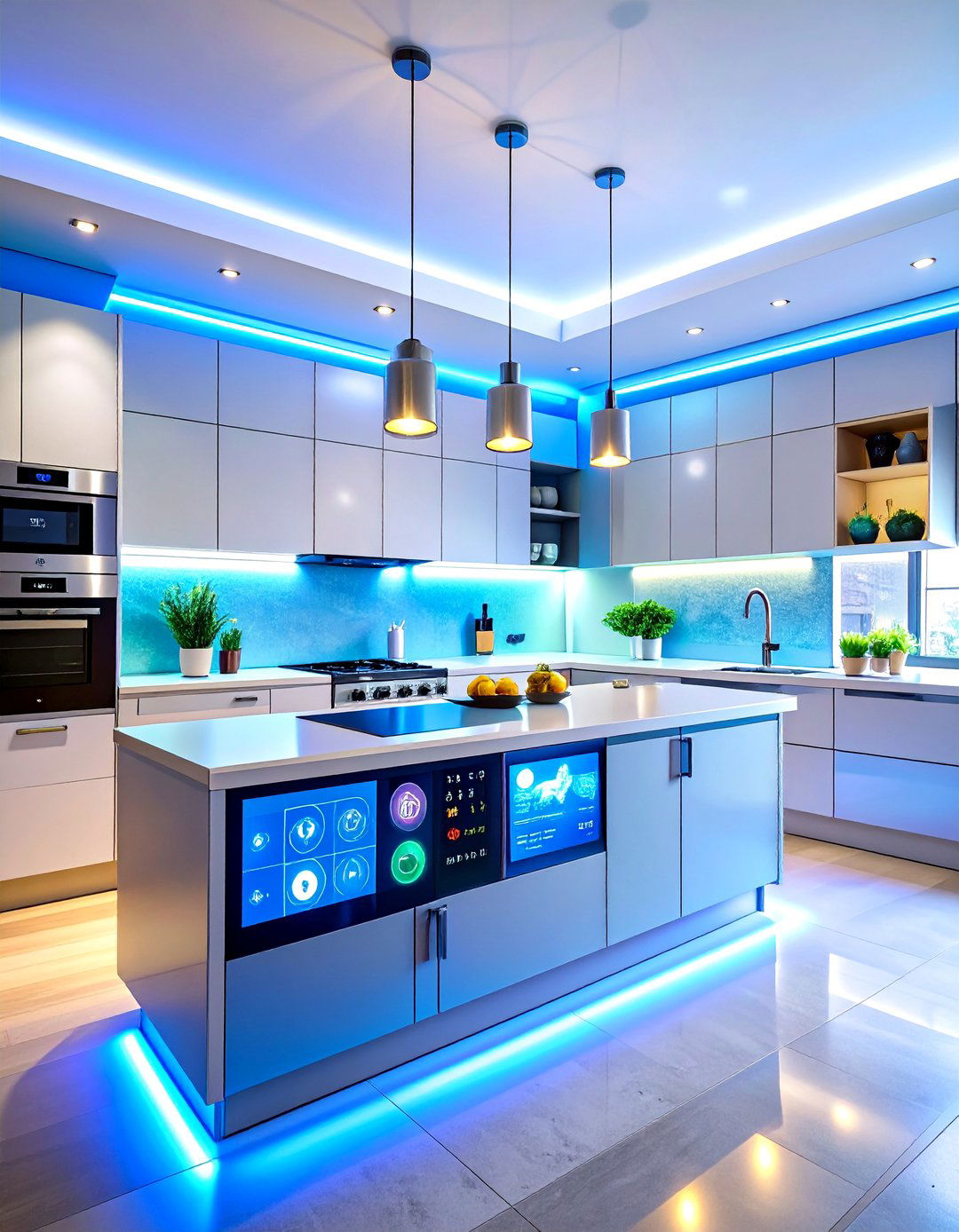
Smart kitchen lighting systems enable precise control over color temperature, brightness, and scheduling through smartphone apps and voice commands. Programmable scenes adjust lighting throughout the day, from energizing cool white for morning preparation to warm amber for evening dining. Motion sensors automatically illuminate pathways and work areas when hands are full. Integration with smart home systems allows coordination with other appliances and security features. Color-changing LED strips can provide mood lighting or indicate cooking timers. Smart switches and dimmers offer remote control capabilities, making it easy to adjust lighting from anywhere in the home for optimal convenience and energy efficiency.
9. Kitchen Lighting Glass Cabinet Interior Display
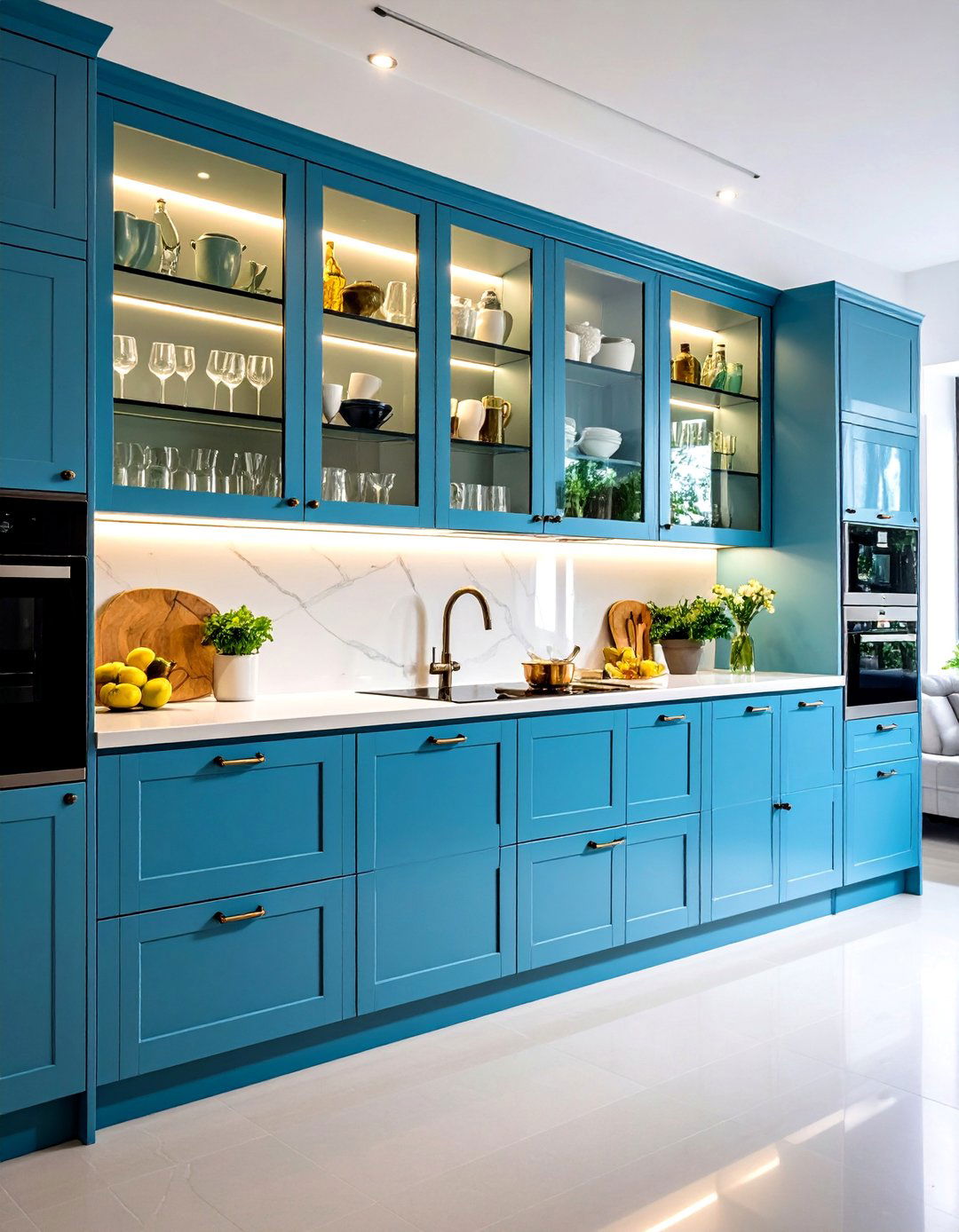
Glass cabinet kitchen lighting showcases dishware, glassware, and decorative items while adding sparkling accents throughout the space. LED strips installed along cabinet sides or tops create museum-quality display lighting that transforms everyday items into focal points. Battery-powered options eliminate wiring concerns for retrofit installations. Warm white lighting enhances the appearance of china and crystal while cool white lighting makes glass items appear crisp and clean. Motion-activated cabinet lights turn on automatically when doors open, providing practical illumination while highlighting beautiful collections. This lighting approach adds depth and visual interest to kitchen designs while demonstrating attention to detail.
10. Kitchen Lighting Natural Material Organic Elements
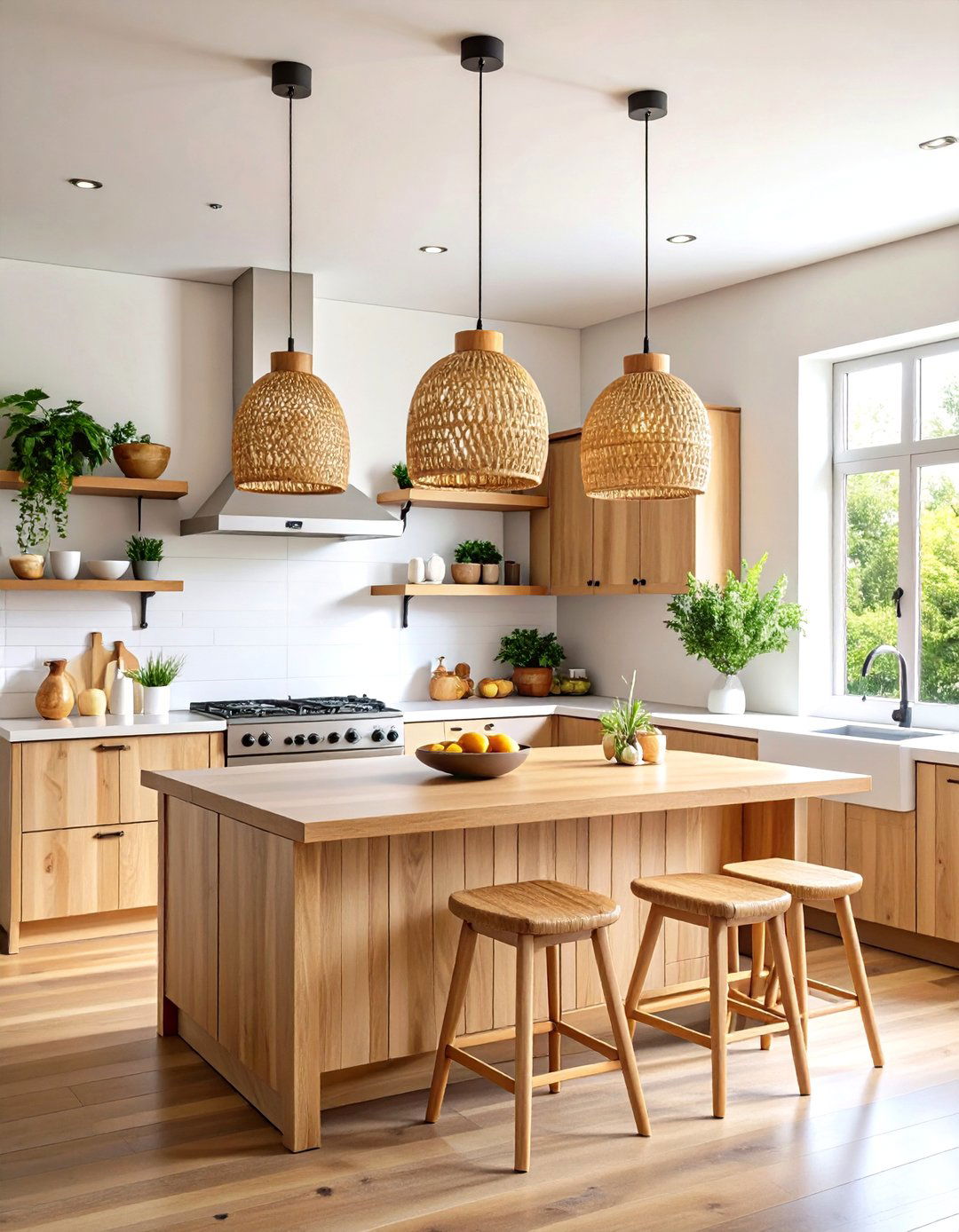
Natural material kitchen lighting embraces organic textures and sustainable design through rattan, wood, bamboo, and stone fixtures. These earthy elements warm modern kitchen spaces while connecting to current biophilic design trends. Woven pendant shades filter light beautifully while adding texture and movement. Live-edge wood fixtures bring unique character with each piece being one-of-a-kind. Stone and ceramic elements provide substantial presence while maintaining connection to natural materials. These fixtures work particularly well in kitchens featuring natural stone countertops, wood cabinetry, or earth-tone color palettes, creating cohesive design narratives that celebrate organic beauty and craftsmanship.
11. Kitchen Lighting Lantern Traditional Character

Lantern-style kitchen lighting brings timeless charm and architectural interest to both traditional and transitional spaces. Modern interpretations feature clean lines and contemporary materials while maintaining classic proportions and open frameworks. These fixtures work exceptionally well over islands where their transparent construction maintains sight lines while providing essential task lighting. Available in various sizes and finishes including aged brass, black iron, and brushed nickel. The open design allows maximum light transmission while the decorative framework adds visual weight and presence. Lantern fixtures bridge indoor and outdoor aesthetics, making them perfect for kitchens that connect to patios or gardens.
12. Kitchen Lighting Curved Linear Contemporary Flow
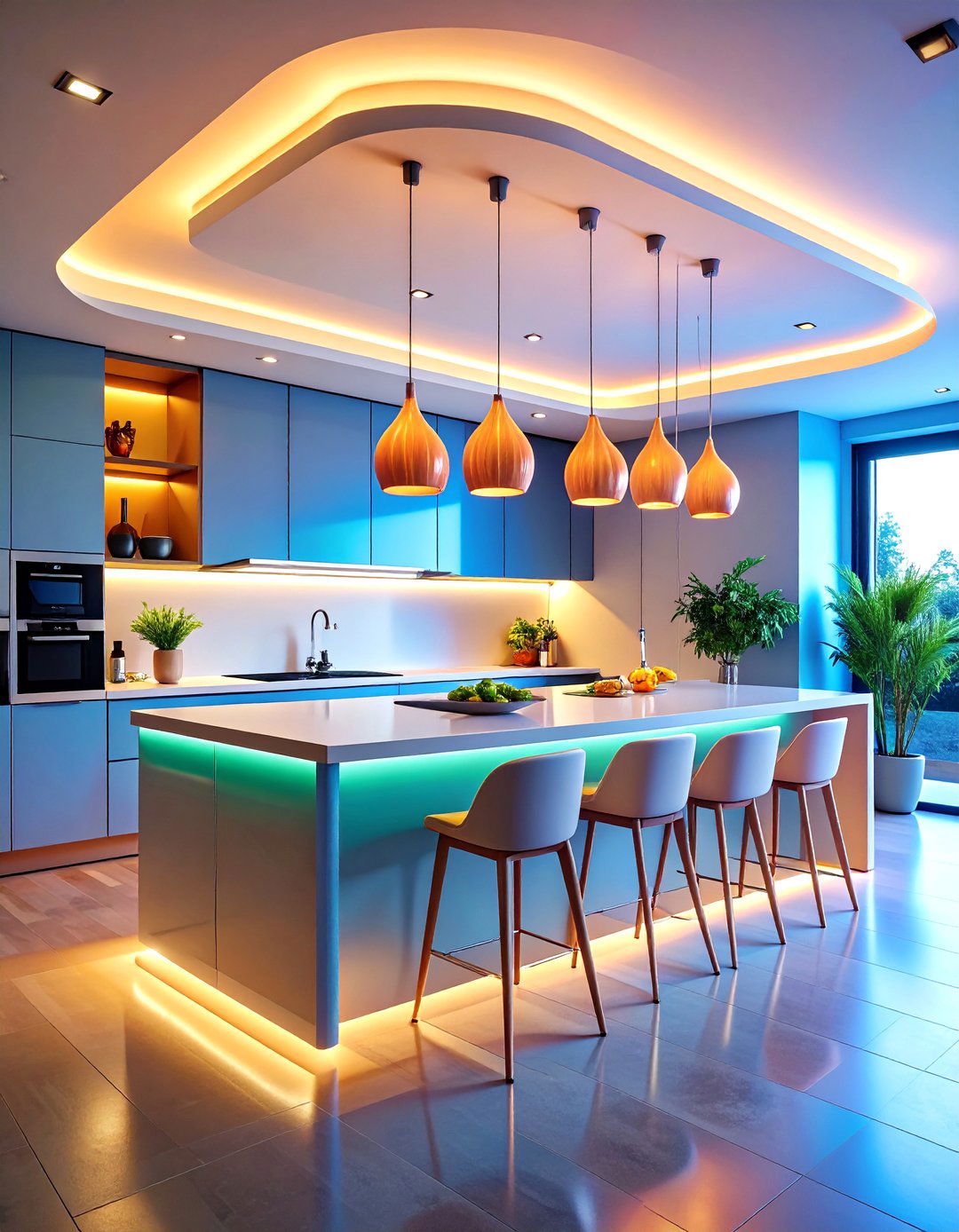
Curved kitchen lighting fixtures represent current design trends moving away from harsh angles toward softer, more organic forms. These flowing designs create visual movement and add sculptural elements to kitchen spaces. Linear curved pendants work beautifully over curved islands or in kitchens with rounded architectural elements. The smooth lines soften stark modern kitchens while maintaining contemporary appeal. Available in various materials including metal, glass, and composite materials. These fixtures often incorporate LED technology for energy efficiency and clean light output. Curved lighting elements create dynamic focal points that draw the eye and add sophisticated design interest to utilitarian spaces.
13. Kitchen Lighting Mixed Metal Finish Coordination
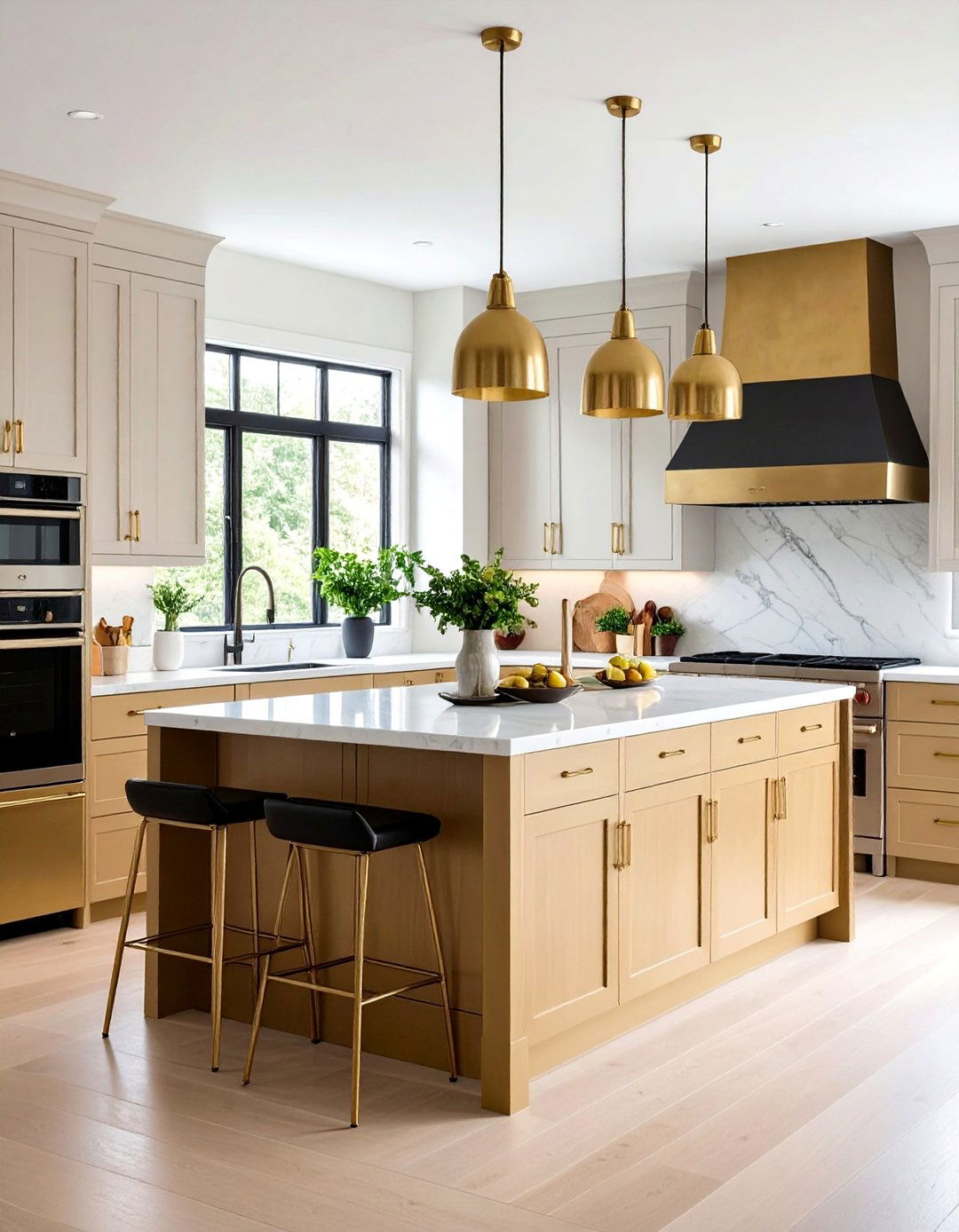
Mixed metal kitchen lighting allows creative coordination with cabinet hardware, faucets, and appliances without requiring exact matching. Popular combinations include warm brass with matte black, brushed nickel with copper accents, and antique bronze with polished chrome details. This approach adds depth and visual interest while preventing the sterile appearance of perfectly matched metals. Mixed finishes work particularly well in transitional kitchens that blend traditional and contemporary elements. The key is maintaining consistent undertones and balancing warm and cool metals throughout the space. This trend enables more personalized kitchen designs while offering flexibility in fixture selection and future updates.
14. Kitchen Lighting Adjustable Beam Directional Control
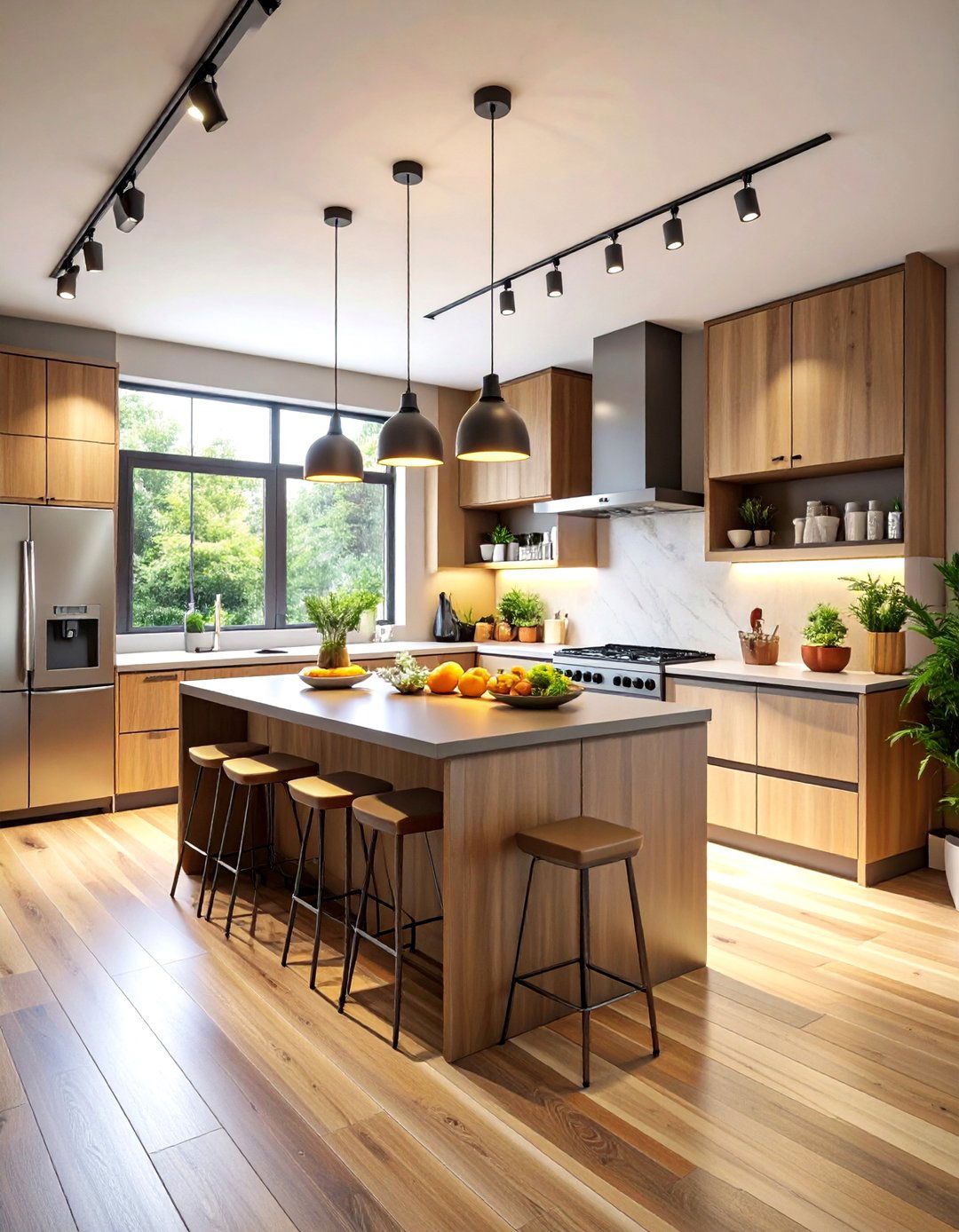
Adjustable beam kitchen lighting provides precise control over light direction and intensity for optimal task illumination. Track-mounted spotlights, adjustable recessed fixtures, and swing-arm sconces enable customization based on specific activities and times of day. Variable beam angles from narrow spots to wide floods accommodate different lighting needs. This flexibility proves invaluable in multipurpose kitchen spaces where lighting requirements change throughout the day. Gimbal trim recessed lights offer 30-degree adjustment ranges while maintaining clean ceiling lines. Professional-grade optics ensure even light distribution without hot spots or shadows. Adjustable systems adapt to changing furniture arrangements and evolving lighting preferences over time.
15. Kitchen Lighting Vintage Retro Revival Elements
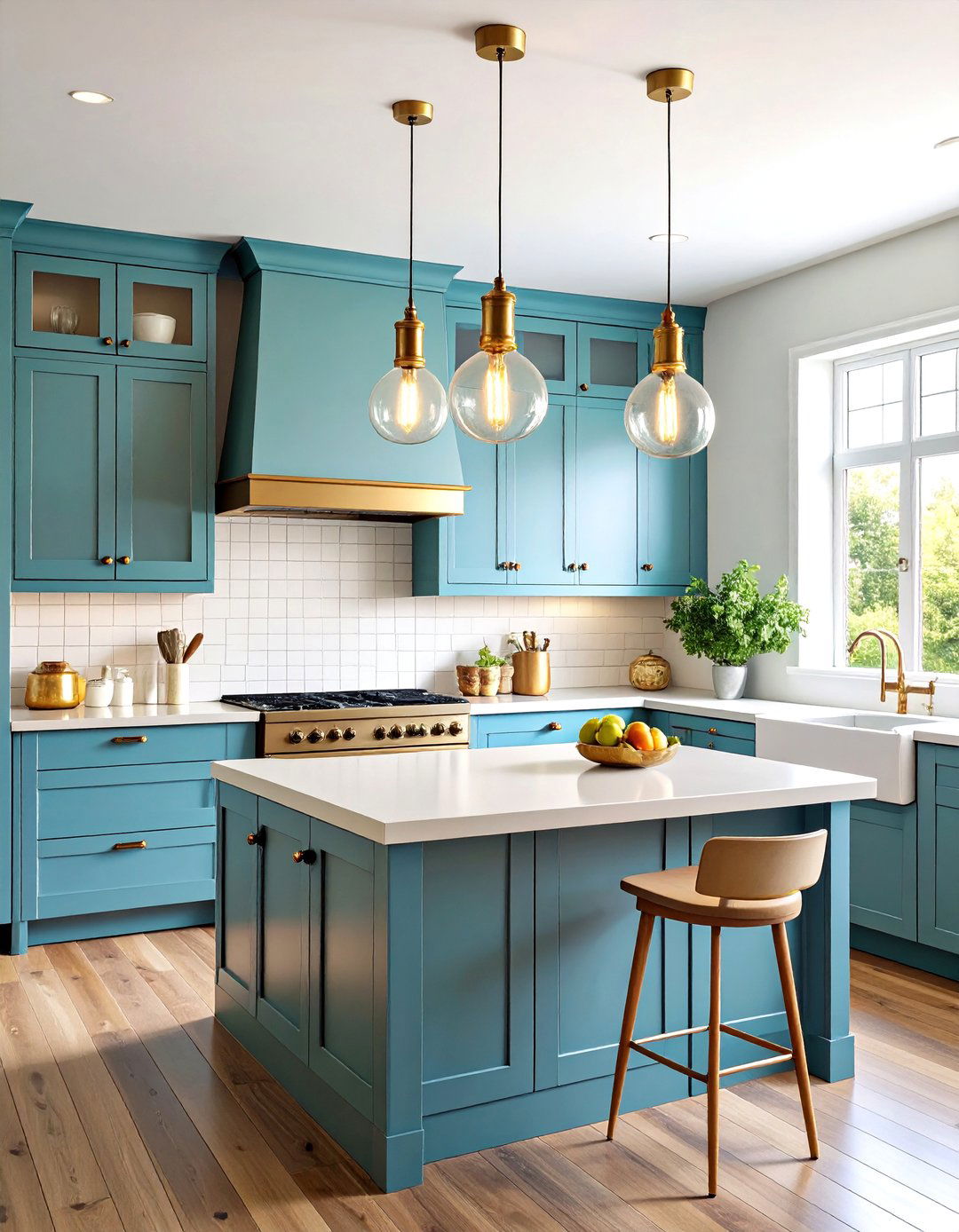
Vintage-inspired kitchen lighting celebrates nostalgic design elements while incorporating modern functionality and energy efficiency. Edison bulb fixtures, brass hardware, and period-appropriate shapes create authentic retro appeal. Mid-century modern designs featuring atomic shapes, starburst patterns, and warm brass finishes complement contemporary kitchen styles. Industrial elements like exposed filaments, metal cages, and utilitarian forms add character and personality. Modern LED technology provides vintage aesthetics without sacrificing efficiency or longevity. These fixtures work particularly well in kitchens featuring subway tiles, natural wood elements, or vintage-inspired appliances, creating cohesive design themes that honor the past while embracing current technology.
16. Kitchen Lighting Layered Ambient Mood Creation
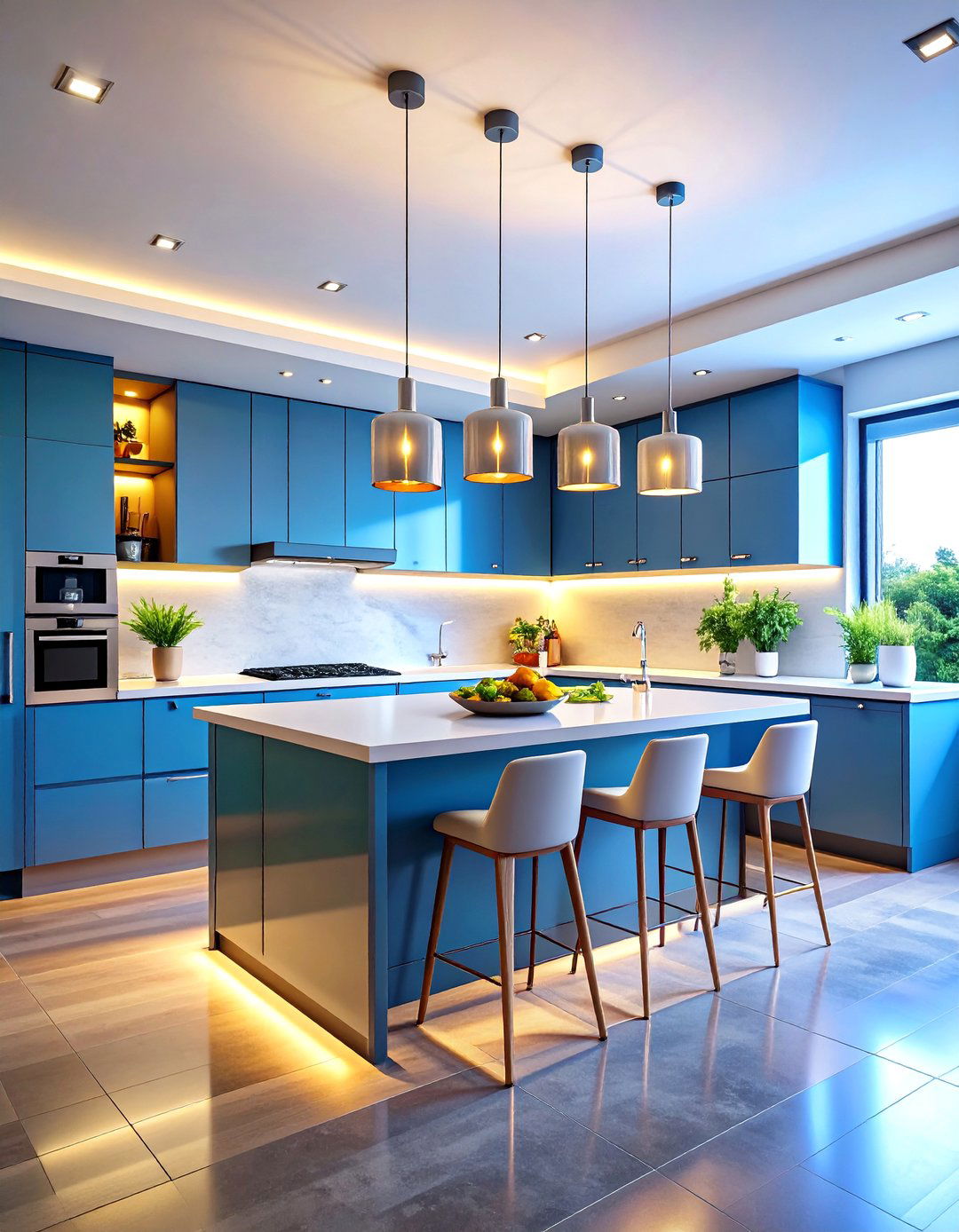
Layered kitchen lighting combines multiple light sources to create flexible ambiance suitable for various activities and moods. This comprehensive approach includes general lighting for overall visibility, task lighting for specific work areas, and accent lighting for visual interest. Dimming controls enable seamless transitions from bright cooking environments to intimate dining atmospheres. Table lamps, floor lamps, and decorative fixtures typically found in living spaces add unexpected warmth to kitchen environments. Battery-powered accent lights provide flexibility without electrical modifications. Layered lighting schemes accommodate everything from energetic morning routines to relaxed evening entertaining, making kitchens truly multifunctional social spaces.
17. Kitchen Lighting Color Temperature Customization
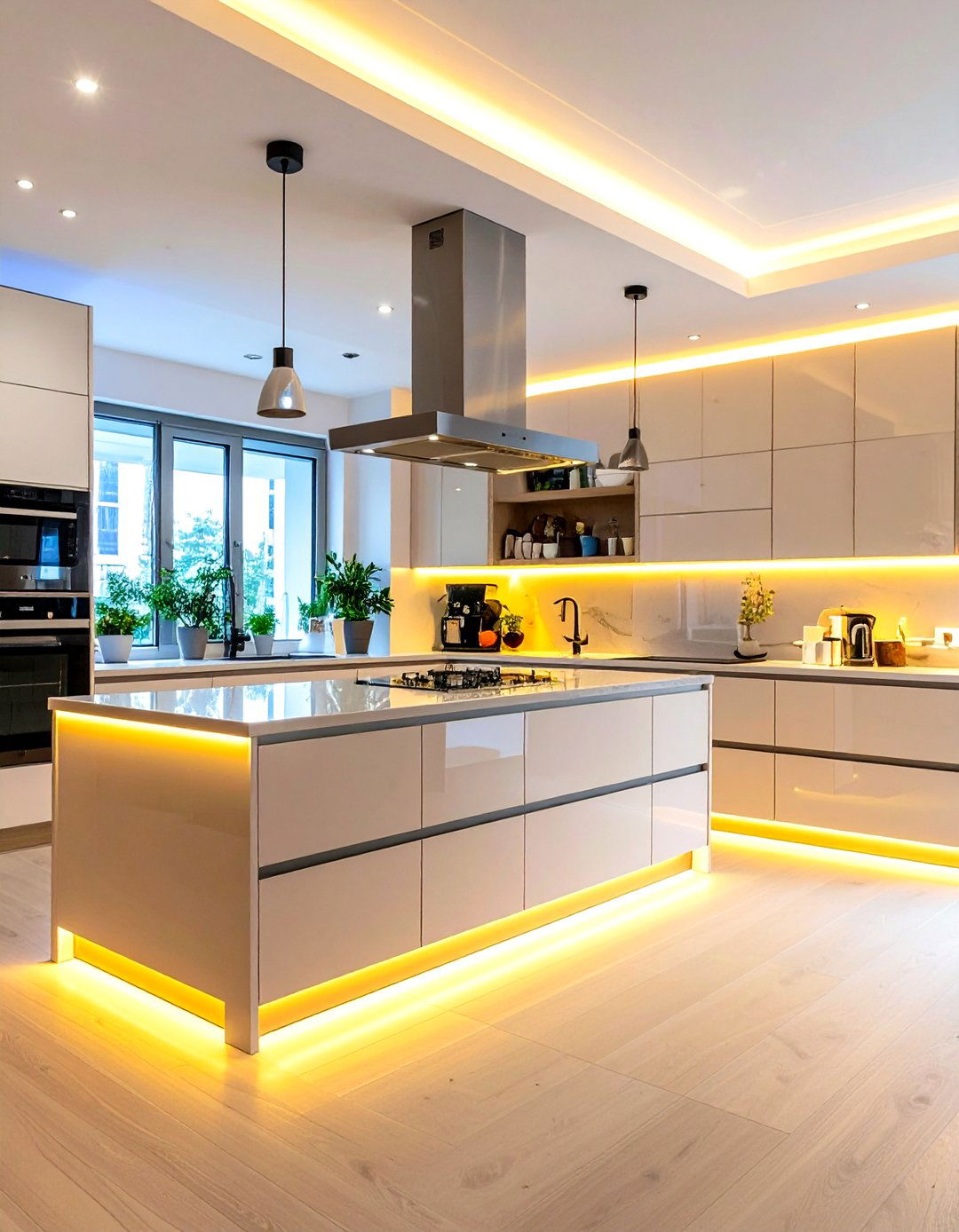
Color temperature kitchen lighting enables optimization for different activities, times of day, and personal preferences throughout the cooking and dining experience. Tunable white LED systems adjust from warm 2700K for relaxing dinner ambiance to cool 5000K for detailed food preparation tasks. Circadian rhythm lighting automatically adjusts color temperature throughout the day, supporting natural sleep cycles while maintaining optimal visibility. Different zones can maintain different color temperatures simultaneously, with warm lighting over dining areas and cool lighting over work surfaces. This technology improves food presentation, reduces eye strain during detailed tasks, and creates more comfortable environments for extended kitchen activities.
18. Kitchen Lighting Floating Shelf Accent Display
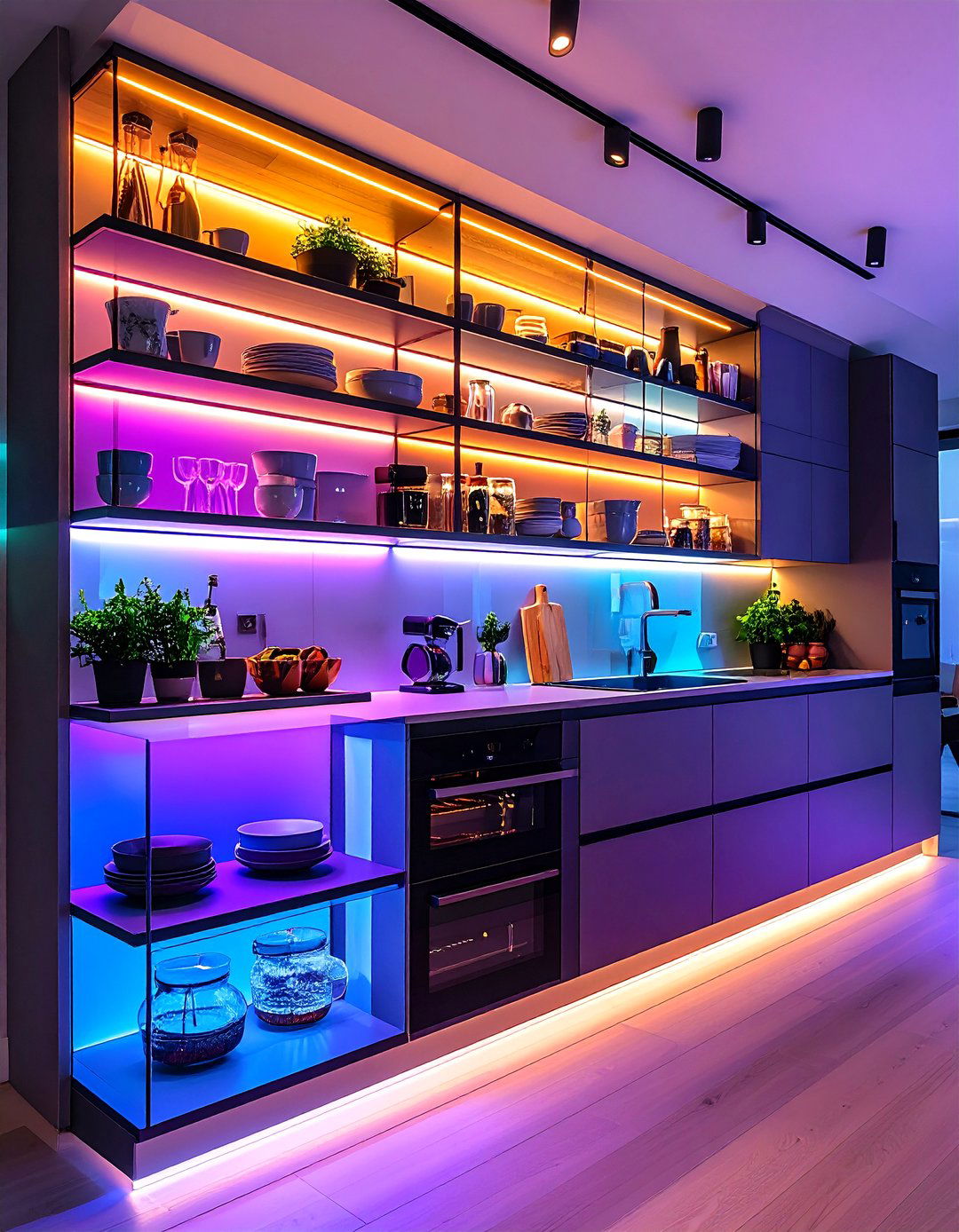
Floating shelf kitchen lighting creates dramatic accent illumination that makes open storage appear to hover while showcasing dishware and decorative objects. LED strips hidden beneath shelf undersides provide upward light reflection while eliminating visible hardware. This technique works particularly well with glass shelves that allow light transmission and create sparkling effects. Warm white lighting enhances wood and ceramic items while cool white lighting makes glassware appear crisp and clean. Motion sensors can activate shelf lighting when approaching storage areas. The combination of functional storage and accent lighting adds architectural interest while keeping frequently used items easily accessible and beautifully displayed.
19. Kitchen Lighting Statement Sculptural Art Pieces
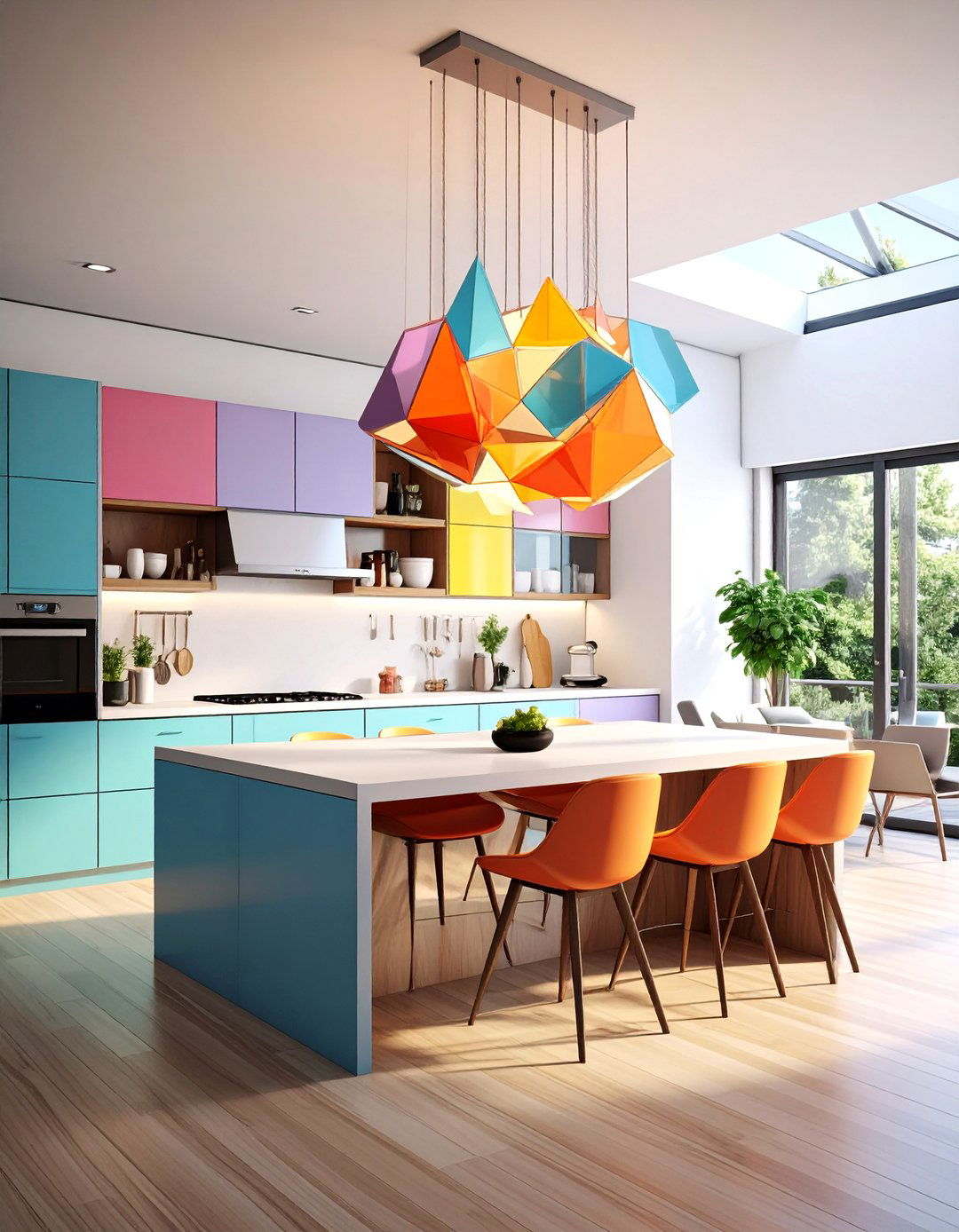
Sculptural kitchen lighting fixtures serve as functional art installations that dramatically transform kitchen aesthetics while providing essential illumination. These oversized or uniquely shaped fixtures become conversation pieces that reflect personal style and design sophistication. Modern options include geometric assemblies, organic forms inspired by nature, and abstract artistic interpretations. Large-scale installations work best in kitchens with high ceilings and open floor plans where their full impact can be appreciated. Materials range from hand-blown glass and forged metal to innovative composites and mixed media. These fixtures often feature integrated LED technology for energy efficiency while maintaining their artistic integrity and visual drama.
20. Kitchen Lighting Professional Task Focused Systems
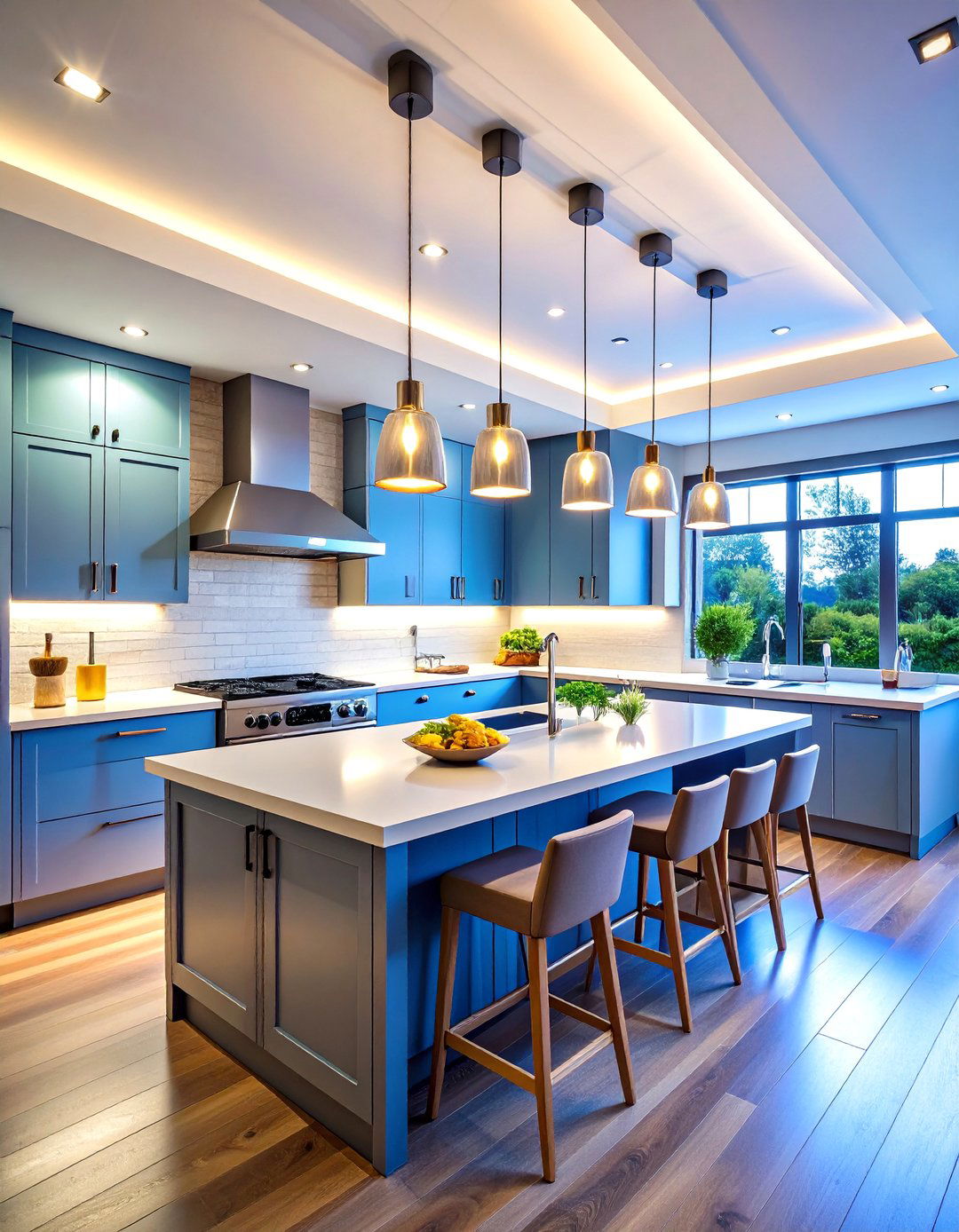
Professional-grade kitchen lighting systems deliver restaurant-quality illumination for serious cooking enthusiasts while maintaining residential aesthetics. High-output LED fixtures provide bright, color-accurate lighting that enhances food preparation precision and presentation. Commercial-inspired track systems offer maximum flexibility for directing light where needed most. Under-cabinet professional strips eliminate all work surface shadows while providing cool operation that won't add heat to the kitchen environment. These systems often include specialized features like timer controls, multiple switching zones, and integration with kitchen ventilation systems. Professional lighting transforms home kitchens into efficient culinary workspaces while supporting both casual cooking and elaborate meal preparation with optimal visibility and functionality.
Conclusion:
The perfect kitchen lighting combines functionality with personal style, creating spaces that seamlessly transition from efficient work environments to welcoming gathering places. By incorporating multiple lighting types and taking advantage of current trends like smart technology, natural materials, and layered illumination, homeowners can create kitchens that truly serve as the heart of the home. Whether updating a single fixture or designing a complete lighting scheme, these ideas provide the foundation for beautiful, functional kitchen lighting that enhances both daily routines and special occasions.


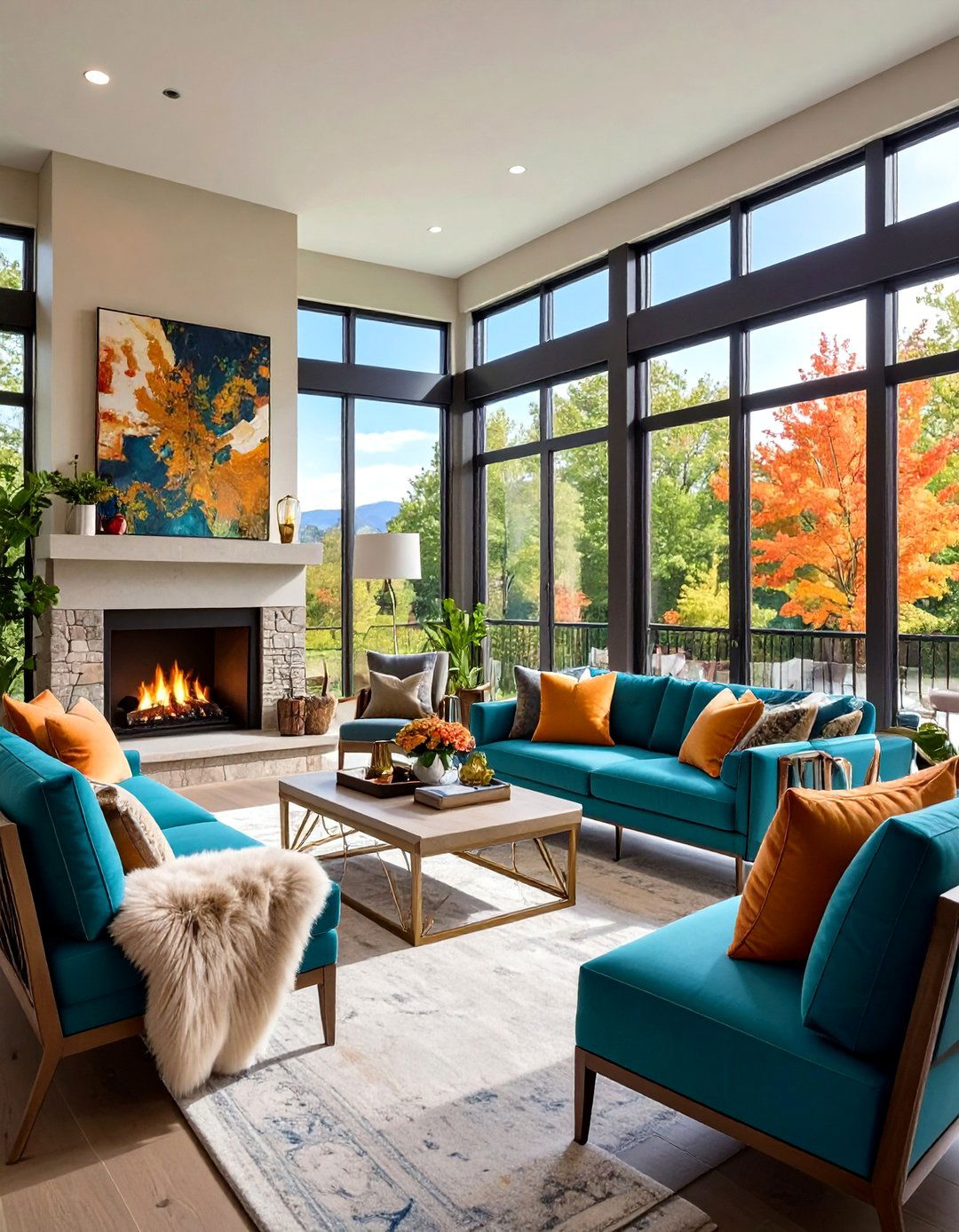
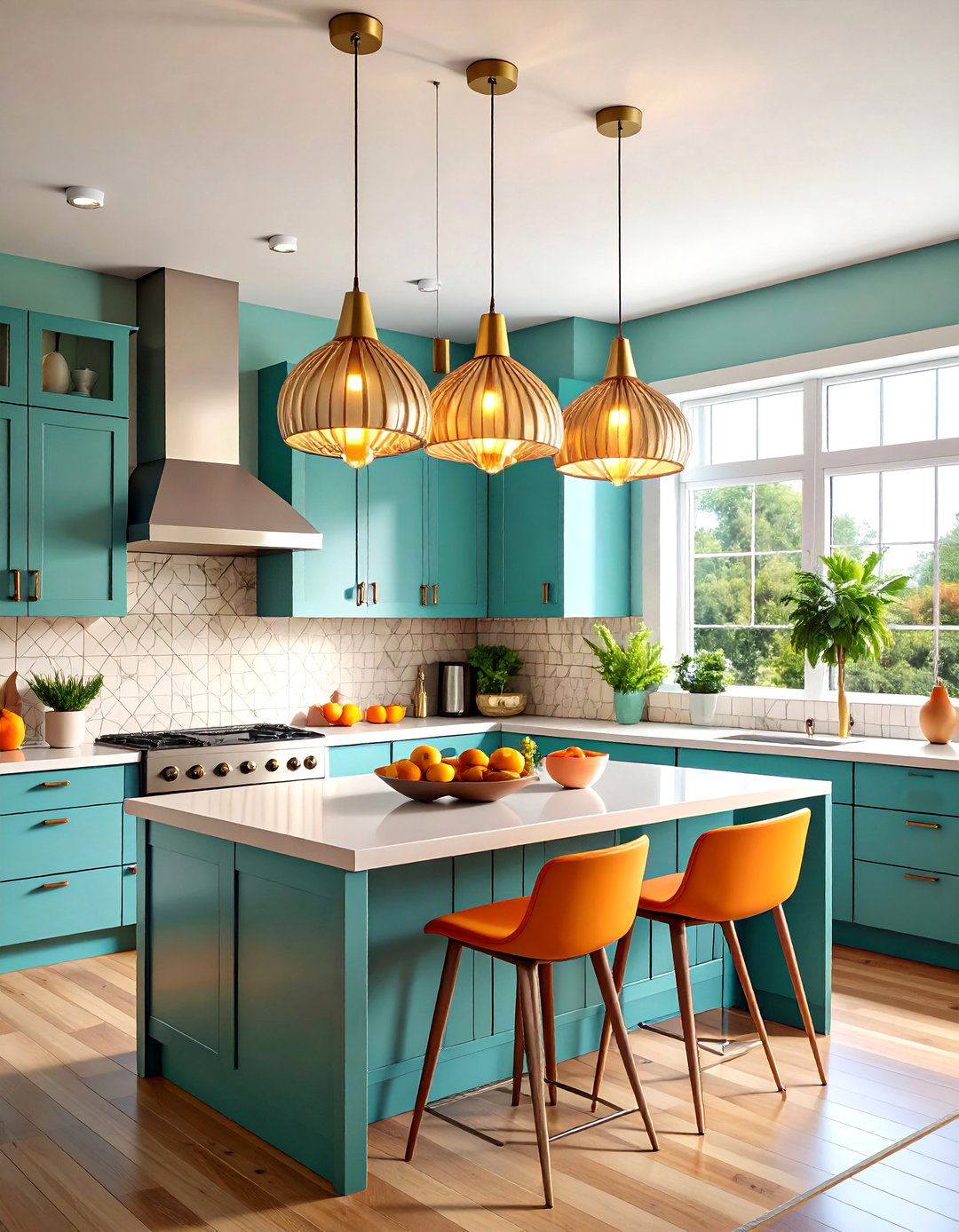
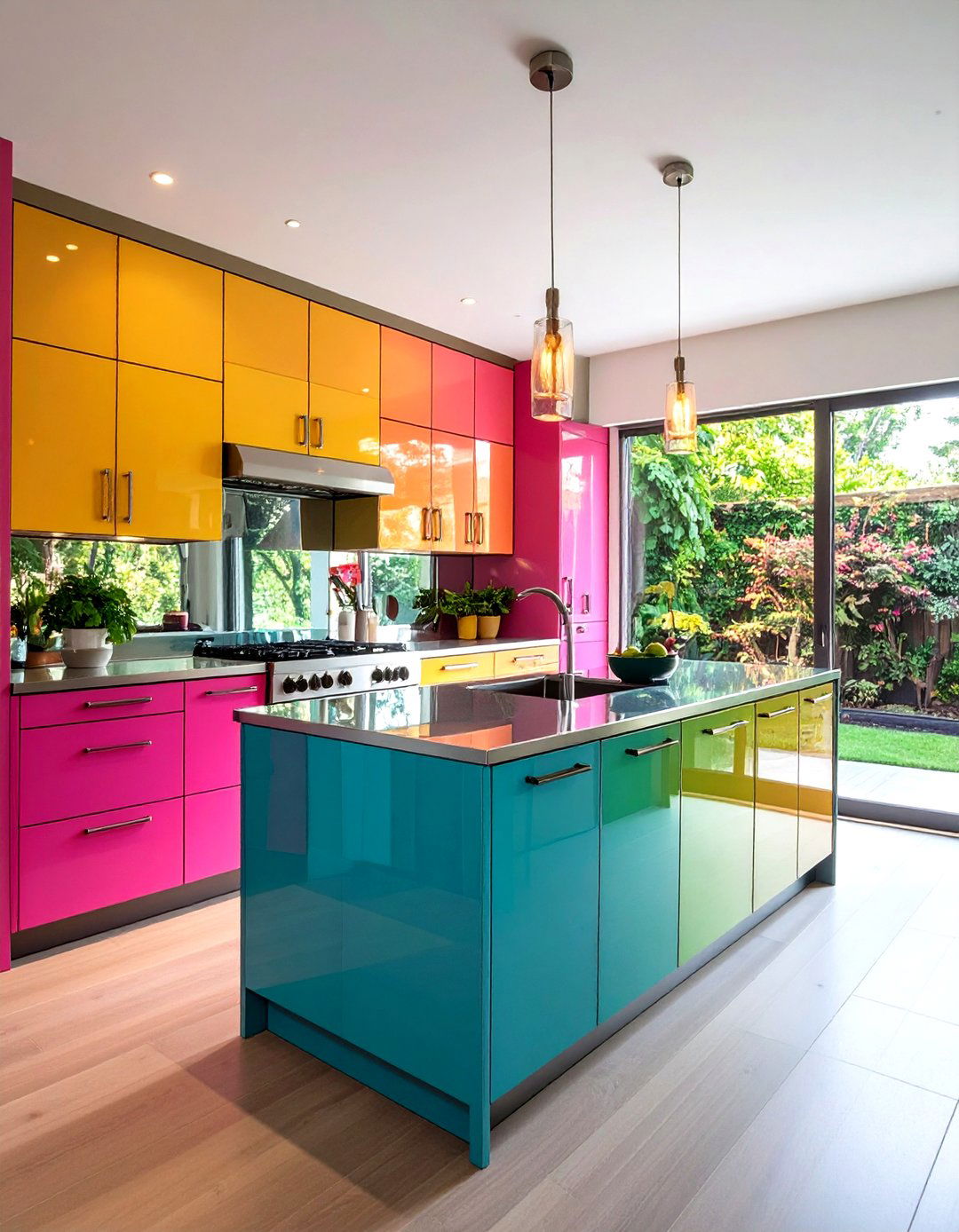
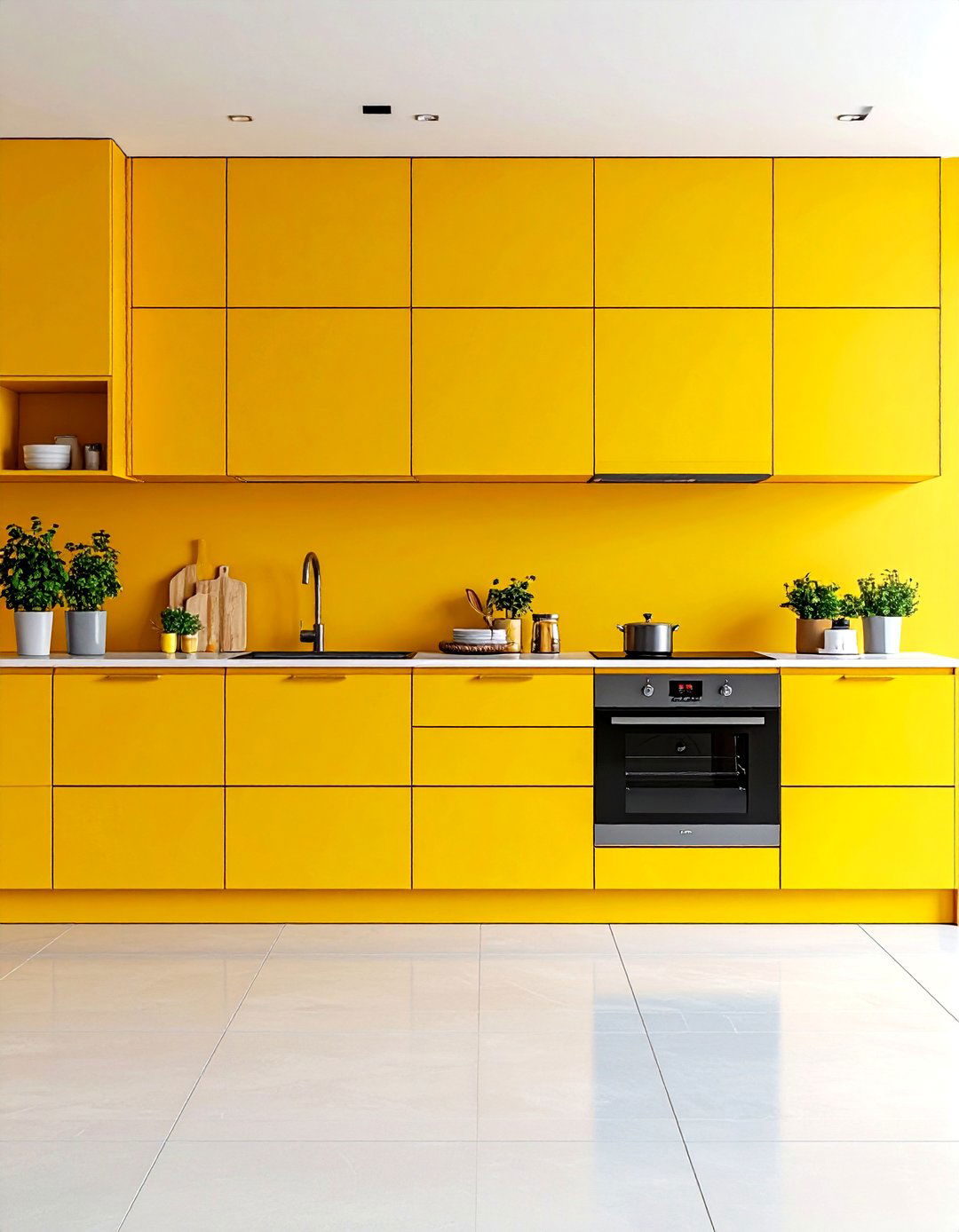



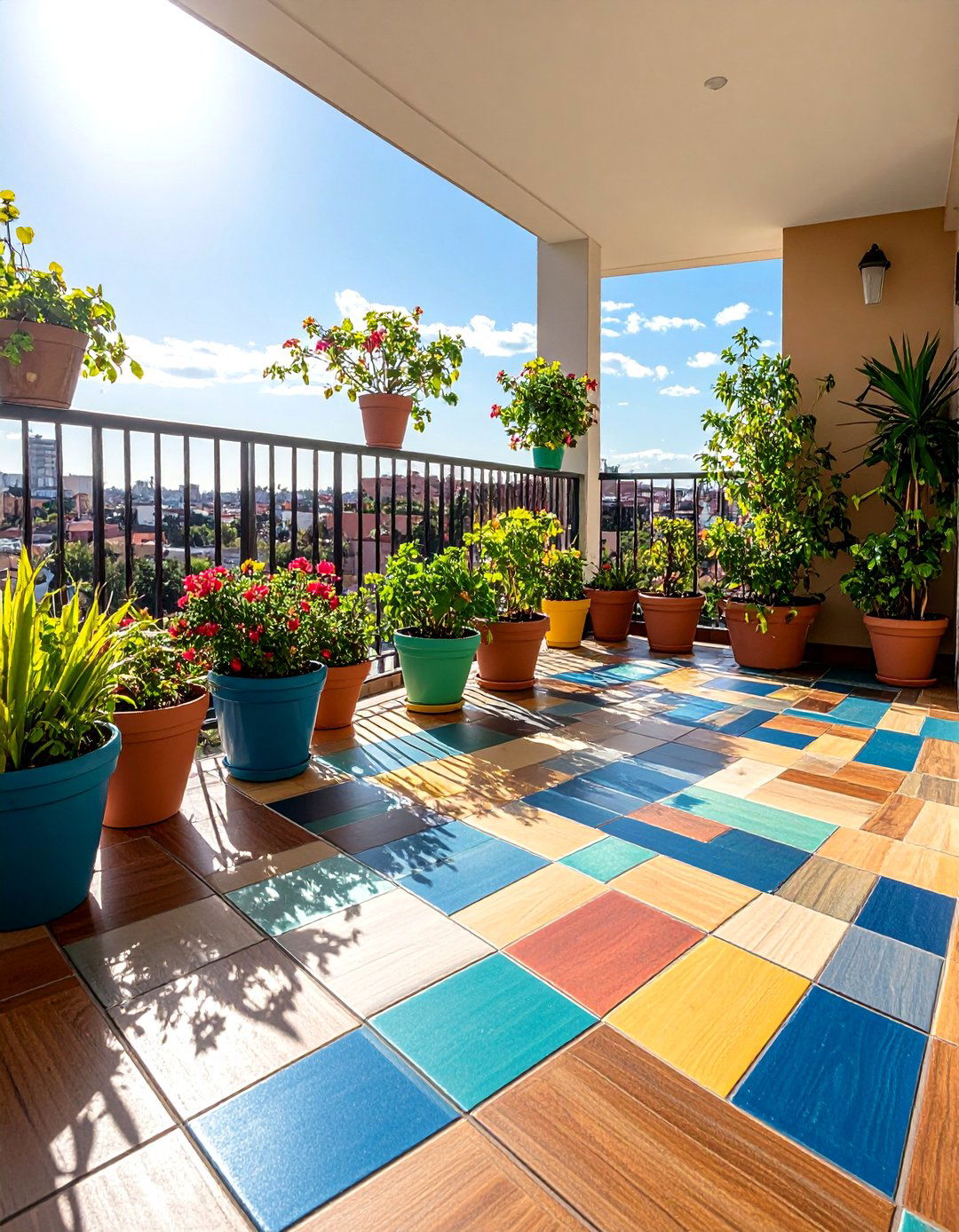
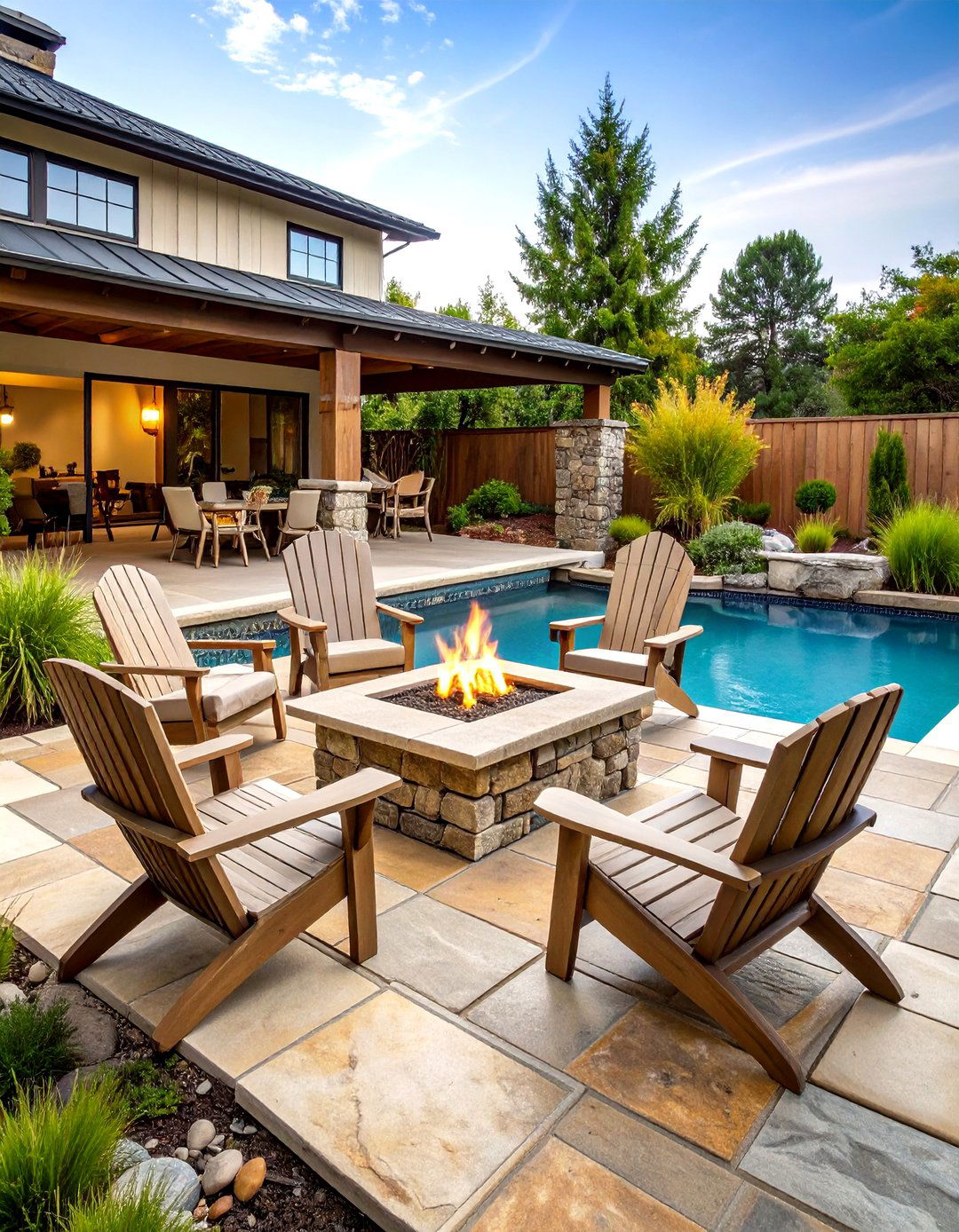


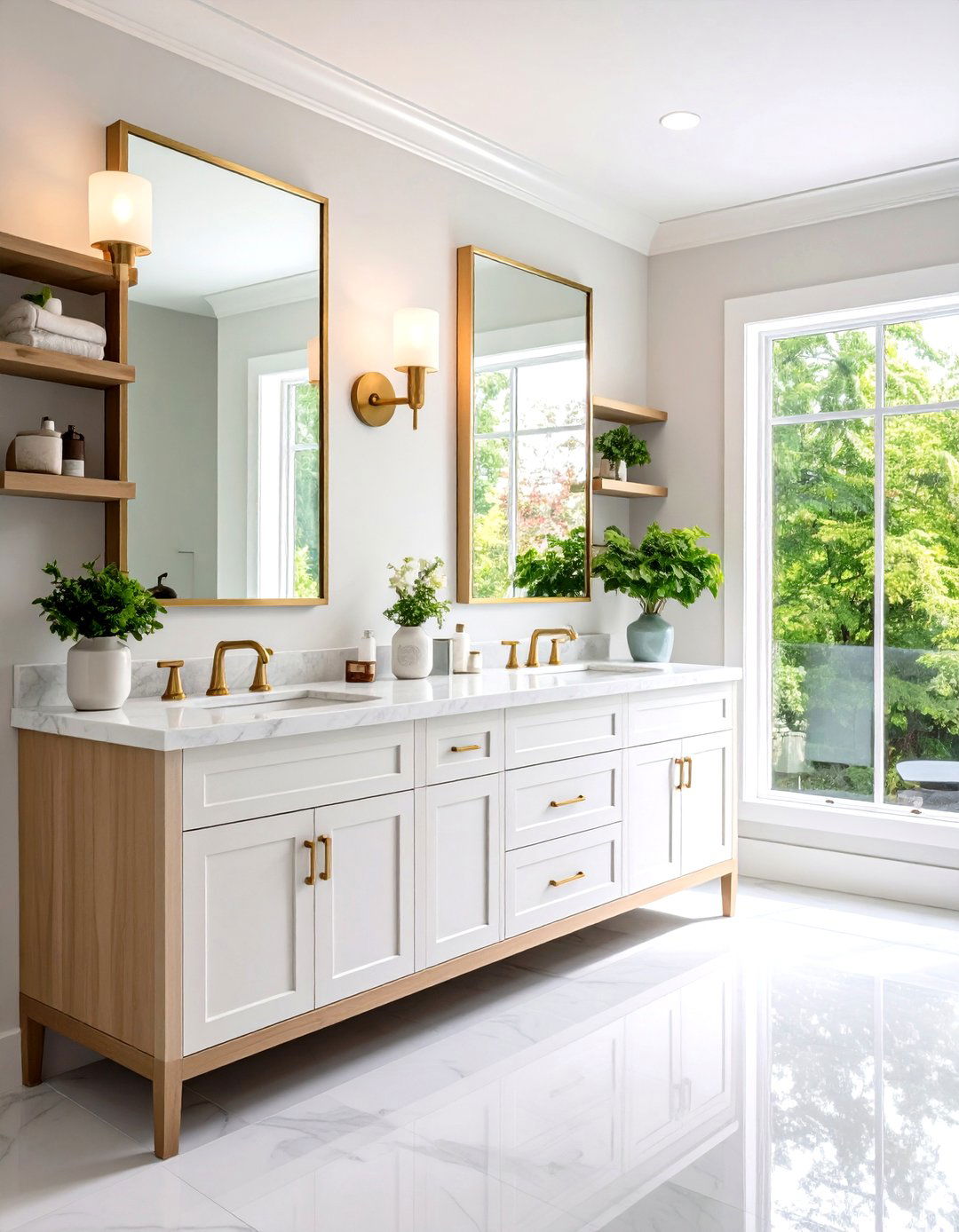
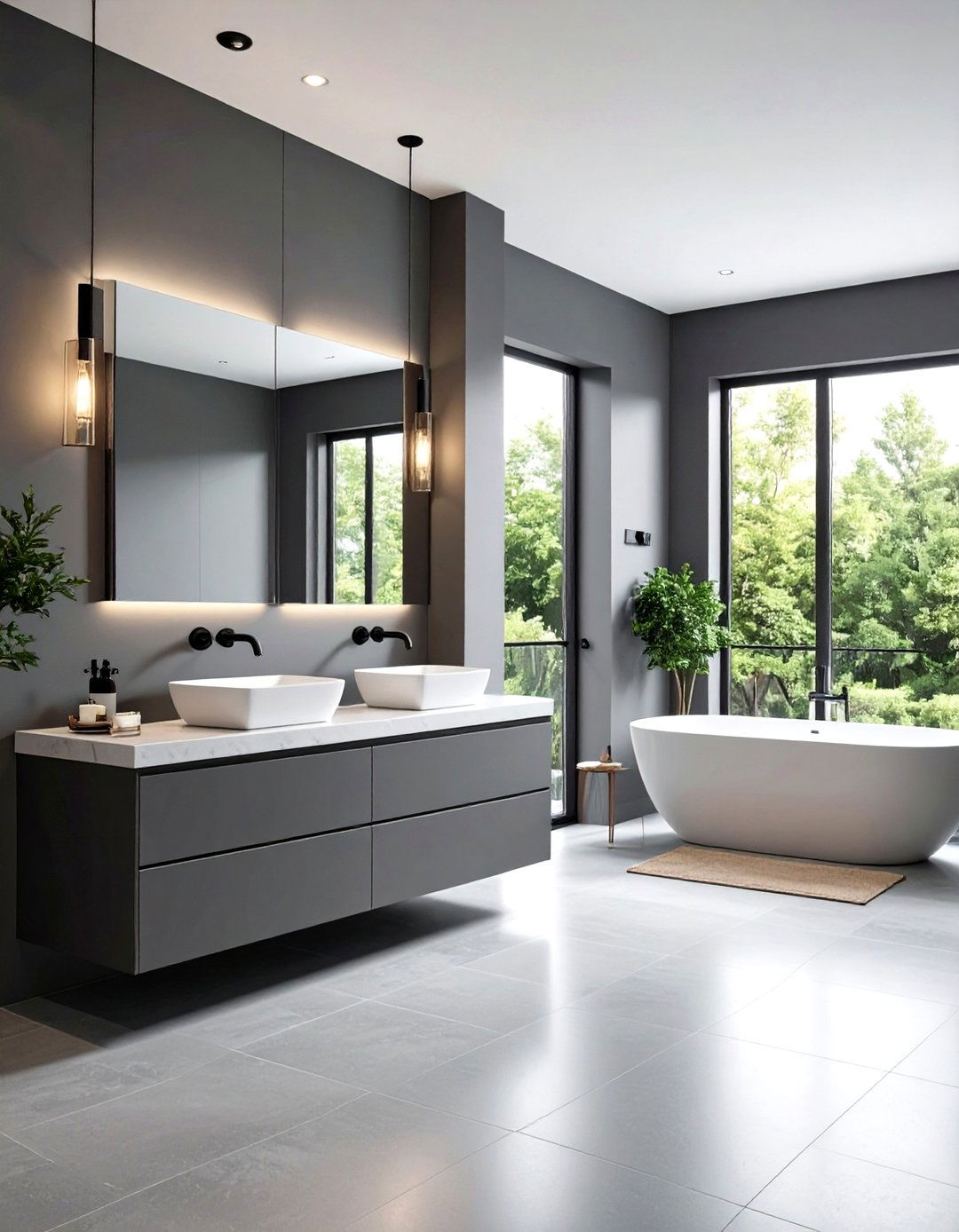
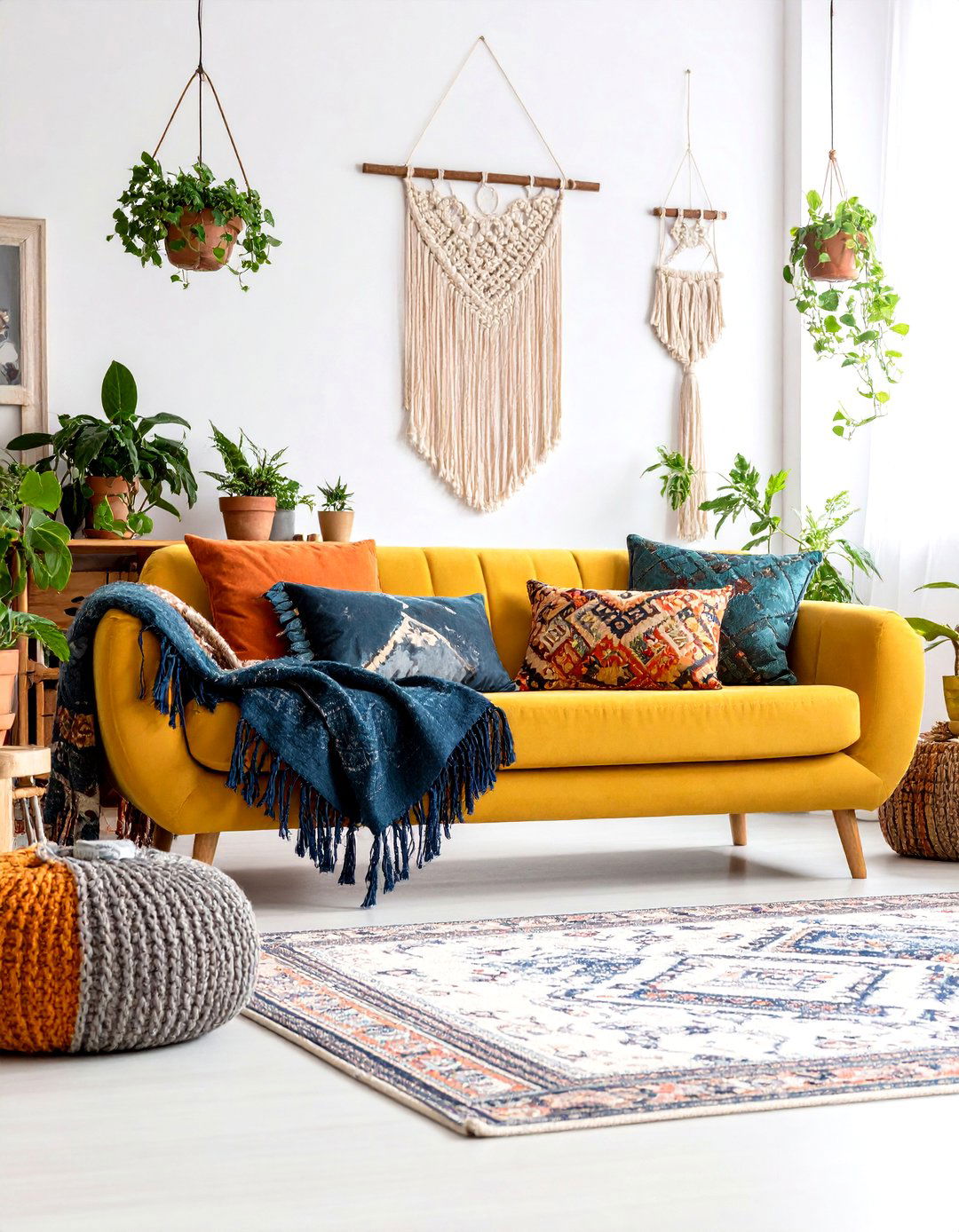
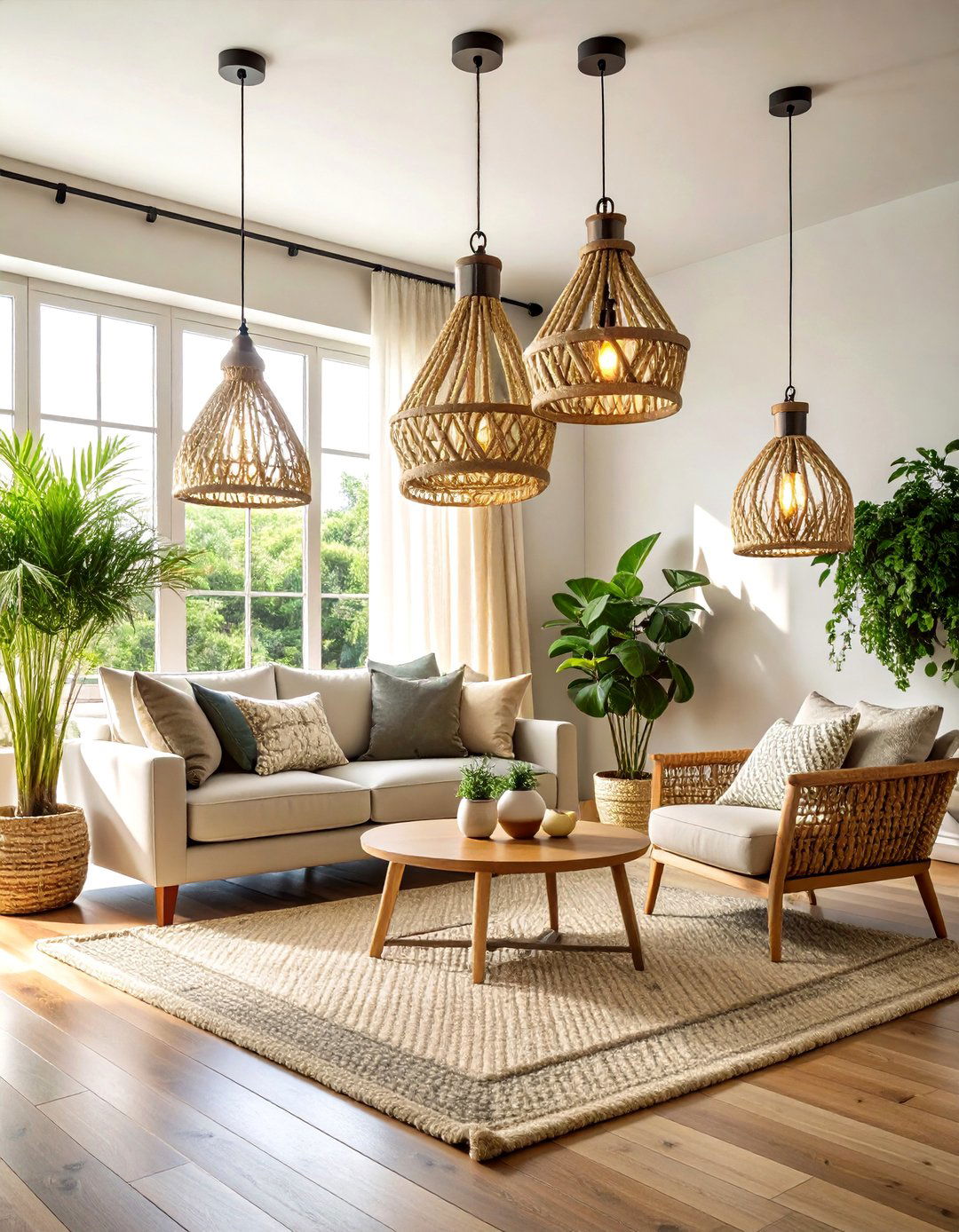
Leave a Reply